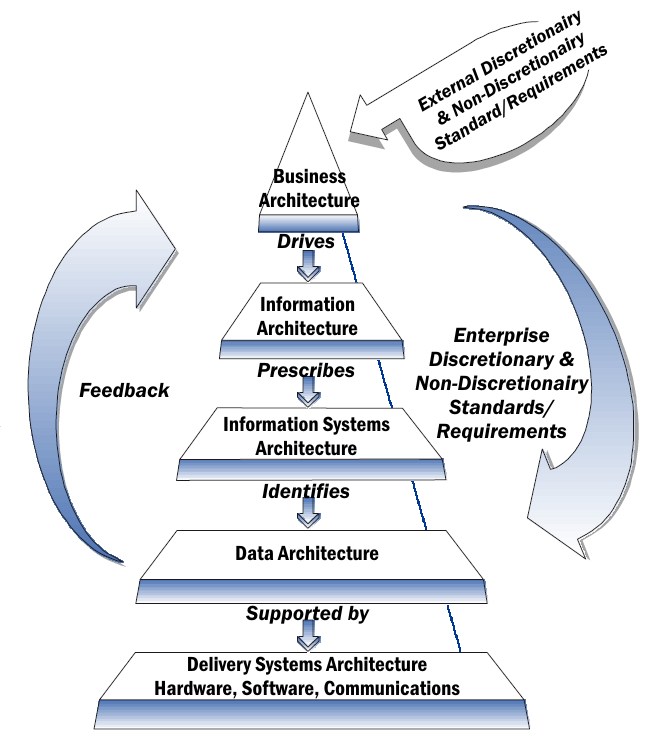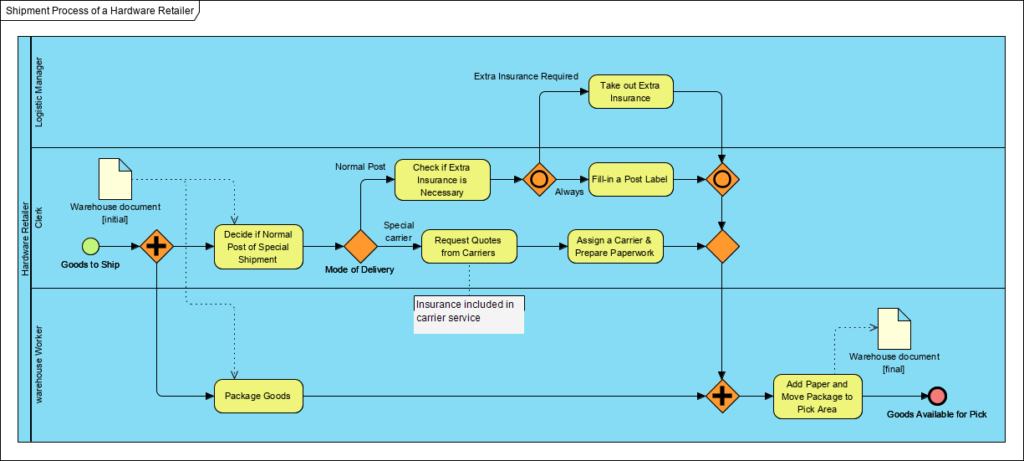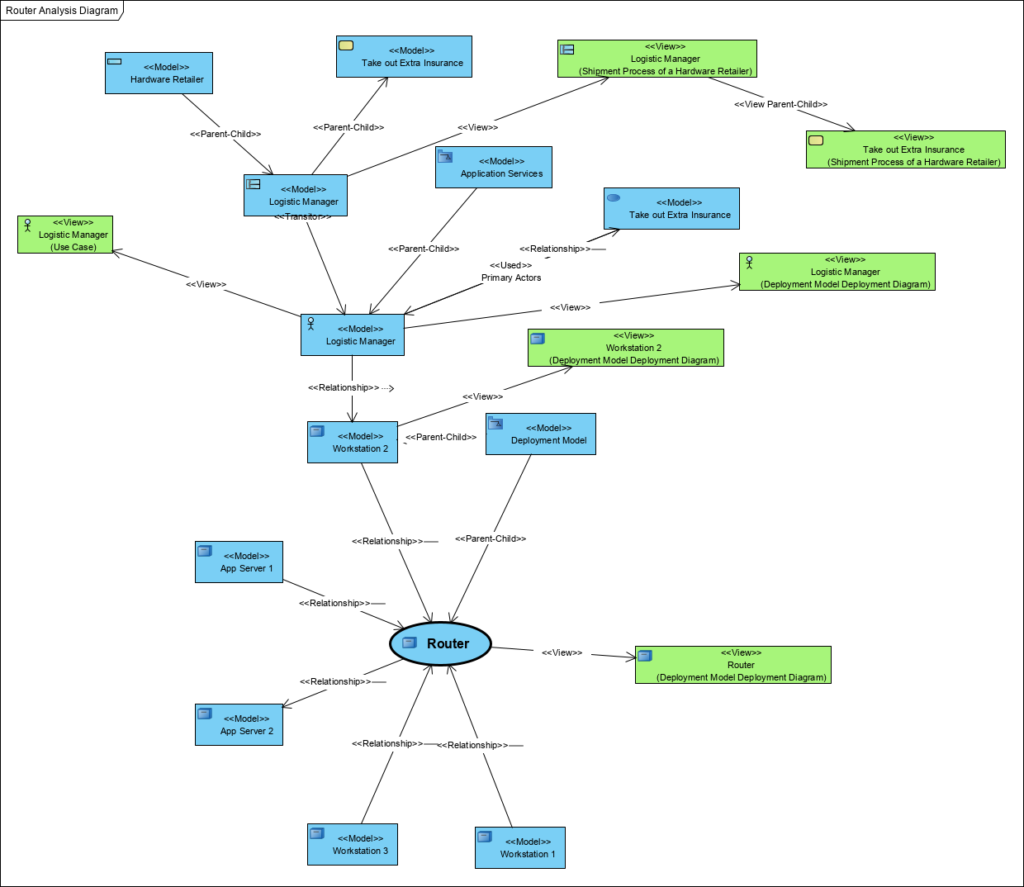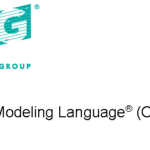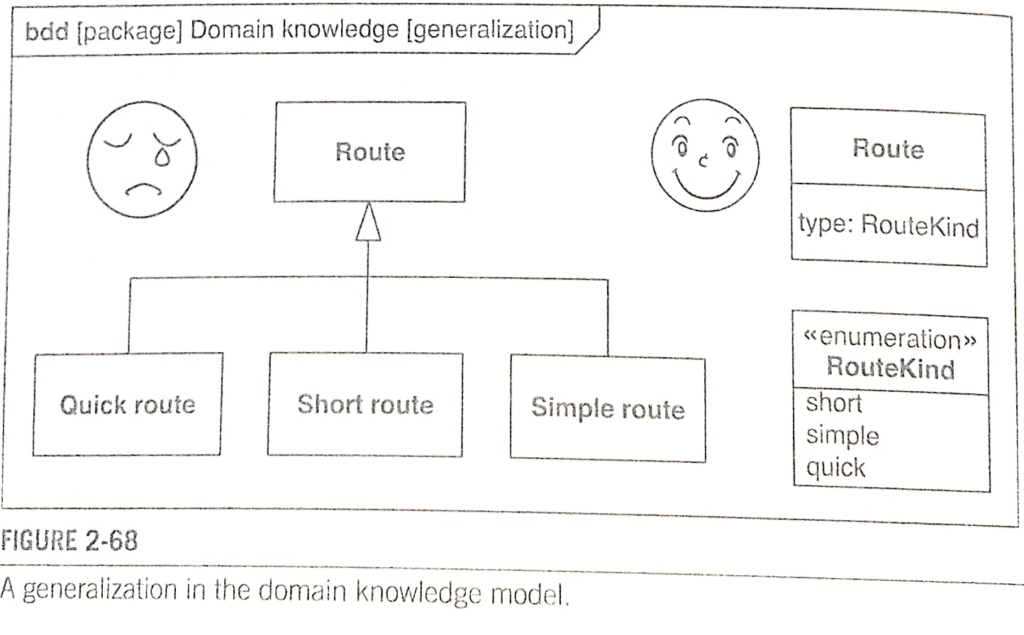Business Continuity Management (BCM) projects are really difficult
How we can managing risks? We can create Business Architecture
(source: https://en.wikipedia.org/wiki/Enterprise_architecture_framework ) How we prepare Enterprise Architecture model? Simple version: prepare business model
Transform this to use case model (application services)
Build matrix for trace mapping control
Trace (map) use case to software components
We have completed model, we can do impact analysis, e.g. what happens and where, when the Ruter go down:
Sometimes we ask: what does the possibility of carrying out the Package Goods task depend on?
How can we do this and what tools do we need? Welcome in my courses, hire me …
References
{5085975:UN79SZ9F};{5085975:5422F6Y7};{5085975:NFKXSVAV};{5085975:5CI9SIEC};{5085975:ESNBXIT3};{5085975:E5R9AI4N};{5085975:5UKRXZIV}
apa
default
asc
0
402
%7B%22status%22%3A%22success%22%2C%22updateneeded%22%3Afalse%2C%22instance%22%3Afalse%2C%22meta%22%3A%7B%22request_last%22%3A700%2C%22request_next%22%3A50%2C%22used_cache%22%3Atrue%7D%2C%22data%22%3A%5B%7B%22key%22%3A%228NAXHSYE%22%2C%22library%22%3A%7B%22id%22%3A5085975%7D%2C%22meta%22%3A%7B%22creatorSummary%22%3A%22Laender%20et%20al.%22%2C%22parsedDate%22%3A%222000%22%2C%22numChildren%22%3A1%7D%2C%22bib%22%3A%22%3Cdiv%20class%3D%5C%22csl-bib-body%5C%22%20style%3D%5C%22line-height%3A%202%3B%20padding-left%3A%201em%3B%20text-indent%3A-1em%3B%5C%22%3E%5Cn%20%20%3Cdiv%20class%3D%5C%22csl-entry%5C%22%3ELaender%2C%20A.%20H.%20F.%2C%20Liddle%2C%20S.%20W.%2C%20%26amp%3B%20Storey%2C%20V.%20C.%20%28Eds.%29.%20%282000%29.%20%3Ci%3EConceptual%20modeling%20-%20ER%202000%3A%2019th%20International%20Conference%20on%20Conceptual%20Modeling%2C%20Salt%20Lake%20City%2C%20Utah%2C%20USA%2C%20October%202000%3C%5C%2Fi%3E.%20Springer.%3C%5C%2Fdiv%3E%5Cn%3C%5C%2Fdiv%3E%22%2C%22data%22%3A%7B%22itemType%22%3A%22book%22%2C%22title%22%3A%22Conceptual%20modeling%20-%20ER%202000%3A%2019th%20International%20Conference%20on%20Conceptual%20Modeling%2C%20Salt%20Lake%20City%2C%20Utah%2C%20USA%2C%20October%202000%22%2C%22creators%22%3A%5B%7B%22creatorType%22%3A%22editor%22%2C%22firstName%22%3A%22Alberto%20H.%20F.%22%2C%22lastName%22%3A%22Laender%22%7D%2C%7B%22creatorType%22%3A%22editor%22%2C%22firstName%22%3A%22Stephen%20W.%22%2C%22lastName%22%3A%22Liddle%22%7D%2C%7B%22creatorType%22%3A%22editor%22%2C%22firstName%22%3A%22Veda%20Catherine%22%2C%22lastName%22%3A%22Storey%22%7D%5D%2C%22abstractNote%22%3A%22%22%2C%22date%22%3A%222000%22%2C%22language%22%3A%22en%22%2C%22ISBN%22%3A%22978-3-540-41072-0%22%2C%22url%22%3A%22%22%2C%22collections%22%3A%5B%5D%2C%22dateModified%22%3A%222020-08-15T12%3A35%3A28Z%22%7D%7D%2C%7B%22key%22%3A%22WYEVVC8U%22%2C%22library%22%3A%7B%22id%22%3A5085975%7D%2C%22meta%22%3A%7B%22creatorSummary%22%3A%22Hause%22%2C%22parsedDate%22%3A%222006%22%2C%22numChildren%22%3A1%7D%2C%22bib%22%3A%22%3Cdiv%20class%3D%5C%22csl-bib-body%5C%22%20style%3D%5C%22line-height%3A%202%3B%20padding-left%3A%201em%3B%20text-indent%3A-1em%3B%5C%22%3E%5Cn%20%20%3Cdiv%20class%3D%5C%22csl-entry%5C%22%3EHause%2C%20M.%20%282006%29.%20The%20SysML%20modelling%20language.%20%3Ci%3EFifteenth%20European%20Systems%20Engineering%20Conference%3C%5C%2Fi%3E%2C%20%3Ci%3E9%3C%5C%2Fi%3E%2C%201%26%23x2013%3B12.%3C%5C%2Fdiv%3E%5Cn%3C%5C%2Fdiv%3E%22%2C%22data%22%3A%7B%22itemType%22%3A%22conferencePaper%22%2C%22title%22%3A%22The%20SysML%20modelling%20language%22%2C%22creators%22%3A%5B%7B%22creatorType%22%3A%22author%22%2C%22firstName%22%3A%22Matthew%22%2C%22lastName%22%3A%22Hause%22%7D%5D%2C%22abstractNote%22%3A%22%22%2C%22date%22%3A%222006%22%2C%22proceedingsTitle%22%3A%22Fifteenth%20European%20Systems%20Engineering%20Conference%22%2C%22conferenceName%22%3A%22%22%2C%22language%22%3A%22%22%2C%22DOI%22%3A%22%22%2C%22ISBN%22%3A%22%22%2C%22url%22%3A%22%22%2C%22collections%22%3A%5B%5D%2C%22dateModified%22%3A%222020-08-12T19%3A07%3A31Z%22%7D%7D%2C%7B%22key%22%3A%22GCZ44JFR%22%2C%22library%22%3A%7B%22id%22%3A5085975%7D%2C%22meta%22%3A%7B%22creatorSummary%22%3A%22Pollack%20et%20al.%22%2C%22parsedDate%22%3A%221975%22%2C%22numChildren%22%3A0%7D%2C%22bib%22%3A%22%3Cdiv%20class%3D%5C%22csl-bib-body%5C%22%20style%3D%5C%22line-height%3A%202%3B%20padding-left%3A%201em%3B%20text-indent%3A-1em%3B%5C%22%3E%5Cn%20%20%3Cdiv%20class%3D%5C%22csl-entry%5C%22%3EPollack%2C%20S.%20L.%2C%20Hicks%2C%20H.%20T.%2C%20%26amp%3B%20Harrison%2C%20W.%20J.%20%281975%29.%20%3Ci%3ETablice%20decyzyjne%3C%5C%2Fi%3E.%20PWN.%3C%5C%2Fdiv%3E%5Cn%3C%5C%2Fdiv%3E%22%2C%22data%22%3A%7B%22itemType%22%3A%22book%22%2C%22title%22%3A%22Tablice%20decyzyjne%22%2C%22creators%22%3A%5B%7B%22creatorType%22%3A%22author%22%2C%22firstName%22%3A%22Solomon%20L.%22%2C%22lastName%22%3A%22Pollack%22%7D%2C%7B%22creatorType%22%3A%22author%22%2C%22firstName%22%3A%22Harry%20T.%22%2C%22lastName%22%3A%22Hicks%22%7D%2C%7B%22creatorType%22%3A%22author%22%2C%22firstName%22%3A%22William%20J.%22%2C%22lastName%22%3A%22Harrison%22%7D%5D%2C%22abstractNote%22%3A%22%22%2C%22date%22%3A%221975%22%2C%22language%22%3A%22pl-PL%22%2C%22ISBN%22%3A%22%22%2C%22url%22%3A%22%22%2C%22collections%22%3A%5B%5D%2C%22dateModified%22%3A%222020-08-12T08%3A13%3A22Z%22%7D%7D%2C%7B%22key%22%3A%22BF3IM7HB%22%2C%22library%22%3A%7B%22id%22%3A5085975%7D%2C%22meta%22%3A%7B%22creatorSummary%22%3A%22Zimmermann%20and%20Pautasso%22%2C%22parsedDate%22%3A%222020-05-18%22%2C%22numChildren%22%3A1%7D%2C%22bib%22%3A%22%3Cdiv%20class%3D%5C%22csl-bib-body%5C%22%20style%3D%5C%22line-height%3A%202%3B%20padding-left%3A%201em%3B%20text-indent%3A-1em%3B%5C%22%3E%5Cn%20%20%3Cdiv%20class%3D%5C%22csl-entry%5C%22%3EZimmermann%2C%20D.%20A.%2C%20%26amp%3B%20Pautasso%2C%20D.%20C.%20%282020%29.%20%3Ci%3EOn%20the%20Evolvability%20Assurance%20of%20Microservices%3A%20Metrics%2C%20Scenarios%2C%20and%20Patterns%3C%5C%2Fi%3E.%20347.%3C%5C%2Fdiv%3E%5Cn%3C%5C%2Fdiv%3E%22%2C%22data%22%3A%7B%22itemType%22%3A%22journalArticle%22%2C%22title%22%3A%22On%20the%20Evolvability%20Assurance%20of%20Microservices%3A%20Metrics%2C%20Scenarios%2C%20and%20Patterns%22%2C%22creators%22%3A%5B%7B%22creatorType%22%3A%22author%22%2C%22firstName%22%3A%22Dr%20Alfred%22%2C%22lastName%22%3A%22Zimmermann%22%7D%2C%7B%22creatorType%22%3A%22author%22%2C%22firstName%22%3A%22Dr%20Cesare%22%2C%22lastName%22%3A%22Pautasso%22%7D%5D%2C%22abstractNote%22%3A%22Fast%20moving%20markets%20and%20the%20age%20of%20digitization%20require%20that%20software%5Cncan%20be%20quickly%20changed%20or%20extended%20with%20new%20features.%20The%20associated%5Cnquality%20attribute%20is%20referred%20to%20as%20evolvability%3A%20the%20degree%20of%20effectiveness%20and%5Cnefficiency%20with%20which%20a%20system%20can%20be%20adapted%20or%20extended.%20Evolvability%20is%5Cnespecially%20important%20for%20software%20with%20frequently%20changing%20requirements%2C%5Cne.g.%20internet-based%20systems.%5CnSeveral%20evolvability-related%20benefits%20were%20arguably%20gained%20with%20the%20rise%5Cnof%20service-oriented%20computing%20%28SOC%29%20that%20established%20itself%20as%20one%20of%20the%5Cnmost%20important%20paradigms%20for%20distributed%20systems%20over%20the%20last%20decade.%5CnThe%20implementation%20of%20enterprise-wide%20software%20landscapes%20in%20the%20style%20of%5Cnservice-oriented%20architecture%20%28SOA%29%20prioritizes%20loose%20coupling%2C%20encapsulation%2C%5Cninteroperability%2C%20composition%2C%20and%20reuse.%20In%20recent%20years%2C%20microservices%5Cnquickly%20gained%20in%20popularity%20as%20an%20agile%2C%20DevOps-focused%2C%20and%20decentralized%5Cnservice-oriented%20variant%20with%20fine-grained%20services.%20A%20key%20idea%20here%20is%5Cnthat%20small%20and%20loosely%20coupled%20services%20that%20are%20independently%20deployable%5Cnshould%20be%20easy%20to%20change%20and%20to%20replace.%20Moreover%2C%20one%20of%20the%20postulated%5Cnmicroservices%20characteristics%20is%20evolutionary%20design.%22%2C%22date%22%3A%2218.05.2020%22%2C%22language%22%3A%22de%22%2C%22DOI%22%3A%22%22%2C%22ISSN%22%3A%22%22%2C%22url%22%3A%22%22%2C%22collections%22%3A%5B%5D%2C%22dateModified%22%3A%222020-08-11T07%3A35%3A36Z%22%7D%7D%2C%7B%22key%22%3A%22IQHKVU5D%22%2C%22library%22%3A%7B%22id%22%3A5085975%7D%2C%22meta%22%3A%7B%22creatorSummary%22%3A%22Marian%20Prze%5Cu0142%5Cu0119cki%22%2C%22parsedDate%22%3A%221993%22%2C%22numChildren%22%3A1%7D%2C%22bib%22%3A%22%3Cdiv%20class%3D%5C%22csl-bib-body%5C%22%20style%3D%5C%22line-height%3A%202%3B%20padding-left%3A%201em%3B%20text-indent%3A-1em%3B%5C%22%3E%5Cn%20%20%3Cdiv%20class%3D%5C%22csl-entry%5C%22%3EMarian%20Prze%26%23x142%3B%26%23x119%3Bcki.%20%281993%29.%20Poj%26%23x119%3Bcie%20prawdy%20w%20j%26%23x119%3Bzykach%20nauk%20empirycznych.%20%3Ci%3EFilozofia%20Nauki%3C%5C%2Fi%3E%2C%20%3Ci%3E1%3C%5C%2Fi%3E%282%26%23x2013%3B3%29%2C%20379%26%23x2013%3B387.%3C%5C%2Fdiv%3E%5Cn%3C%5C%2Fdiv%3E%22%2C%22data%22%3A%7B%22itemType%22%3A%22journalArticle%22%2C%22title%22%3A%22Poj%5Cu0119cie%20prawdy%20w%20j%5Cu0119zykach%20nauk%20empirycznych%22%2C%22creators%22%3A%5B%7B%22creatorType%22%3A%22author%22%2C%22name%22%3A%22Marian%20Prze%5Cu0142%5Cu0119cki%22%7D%5D%2C%22abstractNote%22%3A%22%22%2C%22date%22%3A%221993%22%2C%22language%22%3A%22%22%2C%22DOI%22%3A%22%22%2C%22ISSN%22%3A%22%22%2C%22url%22%3A%22%22%2C%22collections%22%3A%5B%5D%2C%22dateModified%22%3A%222020-08-09T19%3A50%3A17Z%22%7D%7D%2C%7B%22key%22%3A%22TLXETHIY%22%2C%22library%22%3A%7B%22id%22%3A5085975%7D%2C%22meta%22%3A%7B%22creatorSummary%22%3A%22Russell%22%2C%22parsedDate%22%3A%222007%22%2C%22numChildren%22%3A1%7D%2C%22bib%22%3A%22%3Cdiv%20class%3D%5C%22csl-bib-body%5C%22%20style%3D%5C%22line-height%3A%202%3B%20padding-left%3A%201em%3B%20text-indent%3A-1em%3B%5C%22%3E%5Cn%20%20%3Cdiv%20class%3D%5C%22csl-entry%5C%22%3ERussell%2C%20B.%20%282007%29.%20%3Ci%3EAn%20inquiry%20into%20meaning%20and%20truth%3C%5C%2Fi%3E.%20Spokesman.%3C%5C%2Fdiv%3E%5Cn%3C%5C%2Fdiv%3E%22%2C%22data%22%3A%7B%22itemType%22%3A%22book%22%2C%22title%22%3A%22An%20inquiry%20into%20meaning%20and%20truth%22%2C%22creators%22%3A%5B%7B%22creatorType%22%3A%22author%22%2C%22firstName%22%3A%22Bertrand%22%2C%22lastName%22%3A%22Russell%22%7D%5D%2C%22abstractNote%22%3A%22%22%2C%22date%22%3A%222007%22%2C%22language%22%3A%22eng%22%2C%22ISBN%22%3A%22978-0-85124-737-3%22%2C%22url%22%3A%22%22%2C%22collections%22%3A%5B%5D%2C%22dateModified%22%3A%222020-08-09T18%3A05%3A27Z%22%7D%7D%2C%7B%22key%22%3A%22XAX84QFQ%22%2C%22library%22%3A%7B%22id%22%3A5085975%7D%2C%22meta%22%3A%7B%22creatorSummary%22%3A%22Russell%22%2C%22parsedDate%22%3A%222011%22%2C%22numChildren%22%3A0%7D%2C%22bib%22%3A%22%3Cdiv%20class%3D%5C%22csl-bib-body%5C%22%20style%3D%5C%22line-height%3A%202%3B%20padding-left%3A%201em%3B%20text-indent%3A-1em%3B%5C%22%3E%5Cn%20%20%3Cdiv%20class%3D%5C%22csl-entry%5C%22%3ERussell%2C%20B.%20%282011%29.%20%3Ci%3EBadania%20dotycz%26%23x105%3Bce%20znaczenia%20i%20prawdy%3C%5C%2Fi%3E.%20Wydawnictwo%20WAM.%3C%5C%2Fdiv%3E%5Cn%3C%5C%2Fdiv%3E%22%2C%22data%22%3A%7B%22itemType%22%3A%22book%22%2C%22title%22%3A%22Badania%20dotycz%5Cu0105ce%20znaczenia%20i%20prawdy%22%2C%22creators%22%3A%5B%7B%22creatorType%22%3A%22author%22%2C%22firstName%22%3A%22Bertrand%22%2C%22lastName%22%3A%22Russell%22%7D%5D%2C%22abstractNote%22%3A%22%22%2C%22date%22%3A%222011%22%2C%22language%22%3A%22Polish%22%2C%22ISBN%22%3A%22978-83-7505-721-8%22%2C%22url%22%3A%22%22%2C%22collections%22%3A%5B%5D%2C%22dateModified%22%3A%222020-08-09T18%3A03%3A49Z%22%7D%7D%2C%7B%22key%22%3A%226WE68QPI%22%2C%22library%22%3A%7B%22id%22%3A5085975%7D%2C%22meta%22%3A%7B%22creatorSummary%22%3A%22Bi%5Cu0142at%22%2C%22parsedDate%22%3A%222018%22%2C%22numChildren%22%3A0%7D%2C%22bib%22%3A%22%3Cdiv%20class%3D%5C%22csl-bib-body%5C%22%20style%3D%5C%22line-height%3A%202%3B%20padding-left%3A%201em%3B%20text-indent%3A-1em%3B%5C%22%3E%5Cn%20%20%3Cdiv%20class%3D%5C%22csl-entry%5C%22%3EBi%26%23x142%3Bat%2C%20A.%20%282018%29.%20%3Ci%3EMetaontologia%3A%20o%20naturze%20poj%26%23x119%3B%26%23x107%3B%20i%20teorii%20ontologicznych%3C%5C%2Fi%3E%20%28Copernicus%20Center%20Press%2C%20Ed.%29.%20Copernicus%20Center%20Press.%3C%5C%2Fdiv%3E%5Cn%3C%5C%2Fdiv%3E%22%2C%22data%22%3A%7B%22itemType%22%3A%22book%22%2C%22title%22%3A%22Metaontologia%3A%20o%20naturze%20poj%5Cu0119%5Cu0107%20i%20teorii%20ontologicznych%22%2C%22creators%22%3A%5B%7B%22creatorType%22%3A%22author%22%2C%22firstName%22%3A%22Andrzej%22%2C%22lastName%22%3A%22Bi%5Cu0142at%22%7D%2C%7B%22creatorType%22%3A%22editor%22%2C%22name%22%3A%22Copernicus%20Center%20Press%22%7D%5D%2C%22abstractNote%22%3A%22%22%2C%22date%22%3A%222018%22%2C%22language%22%3A%22Polish%22%2C%22ISBN%22%3A%22978-83-7886-347-2%22%2C%22url%22%3A%22%22%2C%22collections%22%3A%5B%5D%2C%22dateModified%22%3A%222020-08-09T16%3A07%3A31Z%22%7D%7D%2C%7B%22key%22%3A%2227STLV4F%22%2C%22library%22%3A%7B%22id%22%3A5085975%7D%2C%22meta%22%3A%7B%22creatorSummary%22%3A%22Marek%20%5Cu0141abuzek%22%2C%22parsedDate%22%3A%222003%22%2C%22numChildren%22%3A1%7D%2C%22bib%22%3A%22%3Cdiv%20class%3D%5C%22csl-bib-body%5C%22%20style%3D%5C%22line-height%3A%202%3B%20padding-left%3A%201em%3B%20text-indent%3A-1em%3B%5C%22%3E%5Cn%20%20%3Cdiv%20class%3D%5C%22csl-entry%5C%22%3EMarek%20%26%23x141%3Babuzek.%20%282003%29.%20Wykorzystanie%20metamodelowania%20do%20specyfikacji%20ontologii%20znaczenia%20opis%26%23xF3%3Bw%20rzeczywisto%26%23x15B%3Bci.%20%3Ci%3Ee-Informatica%20Software%20Engineering%20Journal%3C%5C%2Fi%3E.%20%3Ca%20href%3D%27https%3A%5C%2F%5C%2Fwww.e-informatyka.pl%5C%2Findex.php%5C%2Fpimio%5C%2Finzynieria-wymagan%5C%2Fwykorzystanie-metamodelowania-do-specyfikacji-ontologii-znaczenia-opisow-rzeczywistosci%5C%2F%27%3Ehttps%3A%5C%2F%5C%2Fwww.e-informatyka.pl%5C%2Findex.php%5C%2Fpimio%5C%2Finzynieria-wymagan%5C%2Fwykorzystanie-metamodelowania-do-specyfikacji-ontologii-znaczenia-opisow-rzeczywistosci%5C%2F%3C%5C%2Fa%3E%3C%5C%2Fdiv%3E%5Cn%3C%5C%2Fdiv%3E%22%2C%22data%22%3A%7B%22itemType%22%3A%22journalArticle%22%2C%22title%22%3A%22Wykorzystanie%20metamodelowania%20do%20specyfikacji%20ontologii%20znaczenia%20opis%5Cu00f3w%20rzeczywisto%5Cu015bci%22%2C%22creators%22%3A%5B%7B%22creatorType%22%3A%22author%22%2C%22name%22%3A%22Marek%20%5Cu0141abuzek%22%7D%5D%2C%22abstractNote%22%3A%22Rozdzia%5Cu0142%20przedstawia%20metod%5Cu0119%20specyfikacji%20znaczenia%20tekst%5Cu00f3w%20opis%5Cu00f3w%20rzeczywisto%5Cu015bci%20wykorzystywanych%20we%20wczesnych%20etapach%20projektowania%20system%5Cu00f3w%20informatycznych.%20Znaczenie%20tekstu%20jest%20rozumiane%20jako%20zawarta%20w%20nim%20wiedza.%20Specyfikacja%20znaczenia%20wykorzystuje%20technik%5Cu0119%20metamodelowania%20do%20%5Cu015bcis%5Cu0142ego%20opisu%20struktury%20tej%20wiedzy%20%5Cu2013%20ontologii%20znaczenia.%20Przedstawione%20zostan%5Cu0105%20tak%5Cu017ce%20aspekty%20zwi%5Cu0105zane%20z%20implementacj%5Cu0105%20i%20wykorzystaniem%20ontologii%20%5B%5Cu2026%5D%22%2C%22date%22%3A%222003%22%2C%22language%22%3A%22pl%22%2C%22DOI%22%3A%22%22%2C%22ISSN%22%3A%22%22%2C%22url%22%3A%22https%3A%5C%2F%5C%2Fwww.e-informatyka.pl%5C%2Findex.php%5C%2Fpimio%5C%2Finzynieria-wymagan%5C%2Fwykorzystanie-metamodelowania-do-specyfikacji-ontologii-znaczenia-opisow-rzeczywistosci%5C%2F%22%2C%22collections%22%3A%5B%5D%2C%22dateModified%22%3A%222020-08-09T10%3A54%3A49Z%22%7D%7D%2C%7B%22key%22%3A%22PAKMIYWV%22%2C%22library%22%3A%7B%22id%22%3A5085975%7D%2C%22meta%22%3A%7B%22creatorSummary%22%3A%22Lamentowicz%20and%20Wydawnictwo%20Uniwersytetu%20%5Cu0141%5Cu00f3dzkiego%22%2C%22parsedDate%22%3A%222017%22%2C%22numChildren%22%3A0%7D%2C%22bib%22%3A%22%3Cdiv%20class%3D%5C%22csl-bib-body%5C%22%20style%3D%5C%22line-height%3A%202%3B%20padding-left%3A%201em%3B%20text-indent%3A-1em%3B%5C%22%3E%5Cn%20%20%3Cdiv%20class%3D%5C%22csl-entry%5C%22%3ELamentowicz%2C%20W.%2C%20%26amp%3B%20Wydawnictwo%20Uniwersytetu%20%26%23x141%3B%26%23xF3%3Bdzkiego.%20%282017%29.%20%3Ci%3EStatus%20prawny%20i%20dynamika%20porz%26%23x105%3Bdku%20prawnego%3C%5C%2Fi%3E.%20Wydawnictwo%20Uniwersytetu%20%26%23x141%3B%26%23xF3%3Bdzkiego.%3C%5C%2Fdiv%3E%5Cn%3C%5C%2Fdiv%3E%22%2C%22data%22%3A%7B%22itemType%22%3A%22book%22%2C%22title%22%3A%22Status%20prawny%20i%20dynamika%20porz%5Cu0105dku%20prawnego%22%2C%22creators%22%3A%5B%7B%22creatorType%22%3A%22author%22%2C%22firstName%22%3A%22Wojciech%22%2C%22lastName%22%3A%22Lamentowicz%22%7D%2C%7B%22creatorType%22%3A%22author%22%2C%22name%22%3A%22Wydawnictwo%20Uniwersytetu%20%5Cu0141%5Cu00f3dzkiego%22%7D%5D%2C%22abstractNote%22%3A%22%22%2C%22date%22%3A%222017%22%2C%22language%22%3A%22Polish%22%2C%22ISBN%22%3A%22978-83-8088-677-3%20978-83-8088-745-9%22%2C%22url%22%3A%22%22%2C%22collections%22%3A%5B%5D%2C%22dateModified%22%3A%222020-08-09T10%3A20%3A56Z%22%7D%7D%2C%7B%22key%22%3A%22NEI9JF4B%22%2C%22library%22%3A%7B%22id%22%3A5085975%7D%2C%22meta%22%3A%7B%22creatorSummary%22%3A%22Madkour%20et%20al.%22%2C%22parsedDate%22%3A%222020%22%2C%22numChildren%22%3A3%7D%2C%22bib%22%3A%22%3Cdiv%20class%3D%5C%22csl-bib-body%5C%22%20style%3D%5C%22line-height%3A%202%3B%20padding-left%3A%201em%3B%20text-indent%3A-1em%3B%5C%22%3E%5Cn%20%20%3Cdiv%20class%3D%5C%22csl-entry%5C%22%3EMadkour%2C%20M.%2C%20Butler%2C%20K.%2C%20Mercer%2C%20E.%2C%20Bahrami%2C%20A.%2C%20%26amp%3B%20Tao%2C%20C.%20%282020%29.%20Semantic%20based%20model%20of%20Conceptual%20Work%20Products%20for%20formal%20verification%20of%20complex%20interactive%20systems.%20%3Ci%3EArXiv%20Preprint%20ArXiv%3A2008.01623%3C%5C%2Fi%3E%2C%2011.%3C%5C%2Fdiv%3E%5Cn%3C%5C%2Fdiv%3E%22%2C%22data%22%3A%7B%22itemType%22%3A%22journalArticle%22%2C%22title%22%3A%22Semantic%20based%20model%20of%20Conceptual%20Work%20Products%20for%20formal%20verification%20of%20complex%20interactive%20systems%22%2C%22creators%22%3A%5B%7B%22creatorType%22%3A%22author%22%2C%22firstName%22%3A%22Mohcine%22%2C%22lastName%22%3A%22Madkour%22%7D%2C%7B%22creatorType%22%3A%22author%22%2C%22firstName%22%3A%22Keith%22%2C%22lastName%22%3A%22Butler%22%7D%2C%7B%22creatorType%22%3A%22author%22%2C%22firstName%22%3A%22Eric%22%2C%22lastName%22%3A%22Mercer%22%7D%2C%7B%22creatorType%22%3A%22author%22%2C%22firstName%22%3A%22Ali%22%2C%22lastName%22%3A%22Bahrami%22%7D%2C%7B%22creatorType%22%3A%22author%22%2C%22firstName%22%3A%22Cui%22%2C%22lastName%22%3A%22Tao%22%7D%5D%2C%22abstractNote%22%3A%22Many%20clinical%20workflows%20depend%20on%20interactive%20computer%20systems%20for%20highly%20technical%2C%20conceptual%20work%20products%2C%20such%20as%20diagnoses%2C%20treatment%20plans%2C%20care%20coordination%2C%20and%20case%20management.%20We%20describe%20an%20automatic%20logic%20reasoner%20to%20verify%20objective%20specifications%20for%20these%20highly%20technical%2C%20but%20abstract%2C%20work%20products%20that%20are%20essential%20to%20care.%20The%20conceptual%20work%20products%20specifications%20serve%20as%20a%20fundamental%20output%20requirement%2C%20which%20must%20be%20clearly%20stated%2C%20correct%20and%20solvable.%20There%20is%20strategic%20importance%20for%20such%20specifications%20because%2C%20in%20turn%2C%20they%20enable%20system%20model%20checking%20to%20verify%20that%20machine%20functions%20taken%20with%20user%20procedures%20are%20actually%20able%20to%20achieve%20these%20abstract%20products.%20We%20chose%20case%20management%20of%20Multiple%20Sclerosis%20%28MS%29%20outpatients%20as%20our%20use%20case%20for%20its%20challenging%20complexity.%20As%20a%20first%20step%2C%20we%20illustrate%20how%20graphical%20class%20and%20state%20diagrams%20from%20UML%20can%20be%20developed%20and%20critiqued%20with%20subject%20matter%20experts%20to%20serve%20as%20specifications%20of%20the%20conceptual%20work%20product%20of%20case%20management.%20A%20key%20feature%20is%20that%20the%20specification%20must%20be%20declarative%20and%20thus%20independent%20of%20any%20process%20or%20technology.%20UML%20can%20represent%20the%20needed%20static%20and%20dynamic%20abstractions%20but%20it%20also%20allows%20inconsistent%2C%20unsolvable%20models.%20Our%20Work%20Domain%20Ontology%20with%20tools%20from%20Semantic%20Web%20is%20needed%20to%20translate%20UML%20class%20and%20state%20diagrams%20for%20verification%20of%20solvability%20with%20automatic%20reasoning.%20The%20solvable%20model%20will%20then%20be%20ready%20for%20subsequent%20use%20with%20model%20checking%20on%20the%20system%20of%20human%20procedures%20and%20machine%20functions.%20We%20used%20the%20expressive%20rule%20language%20SPARQL%20Inferencing%20Notation%20%28SPIN%29%20to%20develop%20formal%20representations%20of%20the%20UML%20class%20diagram%2C%20the%20state%20machine%2C%20and%20their%20interactions.%20Using%20SPIN%2C%20we%20proved%20the%20consistency%20of%20the%20interactions%20of%20static%20and%20dynamic%20concepts.%20We%20discuss%20how%20the%20new%20SPIN%20rule%20engine%20could%20be%20incorporated%20in%20the%20Object%20Management%20Group%20%28OMG%29%5Cu2019s%20Ontology%20Definition%20Metamodel%20%28ODM%29.%22%2C%22date%22%3A%222020%22%2C%22language%22%3A%22en%22%2C%22DOI%22%3A%22%22%2C%22ISSN%22%3A%22%22%2C%22url%22%3A%22%22%2C%22collections%22%3A%5B%5D%2C%22dateModified%22%3A%222020-08-09T08%3A27%3A04Z%22%7D%7D%2C%7B%22key%22%3A%22BAQLWB2B%22%2C%22library%22%3A%7B%22id%22%3A5085975%7D%2C%22meta%22%3A%7B%22creatorSummary%22%3A%22Nill%20and%20Sikka%22%2C%22numChildren%22%3A1%7D%2C%22bib%22%3A%22%3Cdiv%20class%3D%5C%22csl-bib-body%5C%22%20style%3D%5C%22line-height%3A%202%3B%20padding-left%3A%201em%3B%20text-indent%3A-1em%3B%5C%22%3E%5Cn%20%20%3Cdiv%20class%3D%5C%22csl-entry%5C%22%3ENill%2C%20C.%2C%20%26amp%3B%20Sikka%2C%20V.%20%28n.d.%29.%20%3Ci%3EModeling%20Software%20Applications%20and%20User%20Interfaces%20Using%20Metaphorical%20Entities%3C%5C%2Fi%3E.%204.%3C%5C%2Fdiv%3E%5Cn%3C%5C%2Fdiv%3E%22%2C%22data%22%3A%7B%22itemType%22%3A%22journalArticle%22%2C%22title%22%3A%22Modeling%20Software%20Applications%20and%20User%20Interfaces%20Using%20Metaphorical%20Entities%22%2C%22creators%22%3A%5B%7B%22creatorType%22%3A%22author%22%2C%22firstName%22%3A%22Christian%22%2C%22lastName%22%3A%22Nill%22%7D%2C%7B%22creatorType%22%3A%22author%22%2C%22firstName%22%3A%22Vishal%22%2C%22lastName%22%3A%22Sikka%22%7D%5D%2C%22abstractNote%22%3A%22The%20power%20of%20metaphor%20has%20long%20been%20recognized%20in%20user%20interface%20design%20and%20more%20broadly%20in%20human%20interaction%20circles.%20More%20recently%20metaphor%20also%20found%20its%20way%20into%20the%20software%20development%20process.%20This%20paper%20aims%20to%20combine%20occurrences%20of%20metaphor%20in%20the%20two%20fields%20with%20ideas%20from%20the%20field%20of%20model%20driven%20architecture.%20We%20suggest%20that%20it%20is%20possible%20to%20create%20conceptual%20patterns%20based%20on%20metaphor%20that%20allow%20a%20high%20level%20description%20of%20interaction%20models%20and%20user%20interfaces%2C%20and%20can%20at%20the%20same%20time%20serve%20as%20structural%20units%20for%20modeling%20software%20applications.%22%2C%22date%22%3A%22%22%2C%22language%22%3A%22en%22%2C%22DOI%22%3A%22%22%2C%22ISSN%22%3A%22%22%2C%22url%22%3A%22%22%2C%22collections%22%3A%5B%5D%2C%22dateModified%22%3A%222020-08-09T07%3A19%3A39Z%22%7D%7D%2C%7B%22key%22%3A%22RE5U5ANM%22%2C%22library%22%3A%7B%22id%22%3A5085975%7D%2C%22meta%22%3A%7B%22creatorSummary%22%3A%22Larson%22%2C%22parsedDate%22%3A%222020%22%2C%22numChildren%22%3A4%7D%2C%22bib%22%3A%22%3Cdiv%20class%3D%5C%22csl-bib-body%5C%22%20style%3D%5C%22line-height%3A%202%3B%20padding-left%3A%201em%3B%20text-indent%3A-1em%3B%5C%22%3E%5Cn%20%20%3Cdiv%20class%3D%5C%22csl-entry%5C%22%3ELarson%2C%20H.%20%282020%29.%20%3Ci%3EAgent-Based%20Modeling%20of%20Locust%20Foraging%20and%20Social%20Behavior%3C%5C%2Fi%3E.%2047.%3C%5C%2Fdiv%3E%5Cn%3C%5C%2Fdiv%3E%22%2C%22data%22%3A%7B%22itemType%22%3A%22journalArticle%22%2C%22title%22%3A%22Agent-Based%20Modeling%20of%20Locust%20Foraging%20and%20Social%20Behavior%22%2C%22creators%22%3A%5B%7B%22creatorType%22%3A%22author%22%2C%22firstName%22%3A%22Hannah%22%2C%22lastName%22%3A%22Larson%22%7D%5D%2C%22abstractNote%22%3A%22%22%2C%22date%22%3A%222020%22%2C%22language%22%3A%22en%22%2C%22DOI%22%3A%22%22%2C%22ISSN%22%3A%22%22%2C%22url%22%3A%22%22%2C%22collections%22%3A%5B%5D%2C%22dateModified%22%3A%222020-08-09T07%3A04%3A12Z%22%7D%7D%2C%7B%22key%22%3A%229KN2ZJQ4%22%2C%22library%22%3A%7B%22id%22%3A5085975%7D%2C%22meta%22%3A%7B%22creatorSummary%22%3A%22Floyd%20and%20Ukena%22%2C%22parsedDate%22%3A%222005%22%2C%22numChildren%22%3A3%7D%2C%22bib%22%3A%22%3Cdiv%20class%3D%5C%22csl-bib-body%5C%22%20style%3D%5C%22line-height%3A%202%3B%20padding-left%3A%201em%3B%20text-indent%3A-1em%3B%5C%22%3E%5Cn%20%20%3Cdiv%20class%3D%5C%22csl-entry%5C%22%3EFloyd%2C%20C.%2C%20%26amp%3B%20Ukena%2C%20S.%20%282005%29.%20On%20Designing%20Ontologies%20for%20Knowledge%20Sharing%20in%20Communities%20of%20Practice.%20%3Ci%3ECAiSE%20Workshops%20%282%29%3C%5C%2Fi%3E%2C%20559%26%23x2013%3B569.%3C%5C%2Fdiv%3E%5Cn%3C%5C%2Fdiv%3E%22%2C%22data%22%3A%7B%22itemType%22%3A%22conferencePaper%22%2C%22title%22%3A%22On%20Designing%20Ontologies%20for%20Knowledge%20Sharing%20in%20Communities%20of%20Practice.%22%2C%22creators%22%3A%5B%7B%22creatorType%22%3A%22author%22%2C%22firstName%22%3A%22Christiane%22%2C%22lastName%22%3A%22Floyd%22%7D%2C%7B%22creatorType%22%3A%22author%22%2C%22firstName%22%3A%22Stefan%22%2C%22lastName%22%3A%22Ukena%22%7D%5D%2C%22abstractNote%22%3A%22Ontologies%20in%20information%20systems%20design%20are%20world%20models%20used%20for%20sharing%20and%20reuse%20of%20knowledge.%20Besides%20formal%20ontologies%2C%20strictly%20based%20on%20logical%20theories%2C%20there%20are%20semi-formal%20ontology%20approaches.%20In%20this%20paper%2C%20ontologies%20are%20viewed%20as%20situated%20in%20human%20activity.%20As%20illustrated%20in%20three%20case%20studies%2C%20they%20embody%20conceptual%20views%20in%20an%20area%20of%20interest%2C%20they%20constitute%20the%20constructed%20reality%20of%20computer%20artifacts%2C%20they%20are%20shaped%20by%20the%20technologies%20chosen%20for%20their%20implementation%2C%20and%20used%20in%20different%20ways%20to%20enhance%20work%20in%20communities%20of%20practice.%20Therefore%2C%20they%20give%20rise%20to%20design%20issues%20like%20useorientation%2C%20flexible%20architecture%20and%20iterative%20development.%22%2C%22date%22%3A%222005%22%2C%22proceedingsTitle%22%3A%22CAiSE%20Workshops%20%282%29%22%2C%22conferenceName%22%3A%22%22%2C%22language%22%3A%22en%22%2C%22DOI%22%3A%22%22%2C%22ISBN%22%3A%22%22%2C%22url%22%3A%22%22%2C%22collections%22%3A%5B%5D%2C%22dateModified%22%3A%222020-08-09T07%3A00%3A57Z%22%7D%7D%2C%7B%22key%22%3A%22J94AAW29%22%2C%22library%22%3A%7B%22id%22%3A5085975%7D%2C%22meta%22%3A%7B%22creatorSummary%22%3A%22uml-diagrams.org%22%2C%22numChildren%22%3A1%7D%2C%22bib%22%3A%22%3Cdiv%20class%3D%5C%22csl-bib-body%5C%22%20style%3D%5C%22line-height%3A%202%3B%20padding-left%3A%201em%3B%20text-indent%3A-1em%3B%5C%22%3E%5Cn%20%20%3Cdiv%20class%3D%5C%22csl-entry%5C%22%3Euml-diagrams.org.%20%28n.d.%29.%20%3Ci%3EExamples%20of%20UML%20composite%20structure%20diagrams%20-%20Bank%20ATM%2C%20Apache%20Tomcat%207%20web%20server%2C%20Observer%20design%20pattern.%3C%5C%2Fi%3E%20%5BUML%20Diagrams%5D.%20UML%20Composite%20Structure%20Diagram%20Examples.%20Retrieved%20August%208%2C%202020%2C%20from%20%3Ca%20href%3D%27https%3A%5C%2F%5C%2Fwww.uml-diagrams.org%5C%2Fcomposite-structure-examples.html%27%3Ehttps%3A%5C%2F%5C%2Fwww.uml-diagrams.org%5C%2Fcomposite-structure-examples.html%3C%5C%2Fa%3E%3C%5C%2Fdiv%3E%5Cn%3C%5C%2Fdiv%3E%22%2C%22data%22%3A%7B%22itemType%22%3A%22webpage%22%2C%22title%22%3A%22Examples%20of%20UML%20composite%20structure%20diagrams%20-%20Bank%20ATM%2C%20Apache%20Tomcat%207%20web%20server%2C%20Observer%20design%20pattern.%22%2C%22creators%22%3A%5B%7B%22creatorType%22%3A%22author%22%2C%22name%22%3A%22uml-diagrams.org%22%7D%5D%2C%22abstractNote%22%3A%22%22%2C%22date%22%3A%22%22%2C%22url%22%3A%22https%3A%5C%2F%5C%2Fwww.uml-diagrams.org%5C%2Fcomposite-structure-examples.html%22%2C%22language%22%3A%22%22%2C%22collections%22%3A%5B%5D%2C%22dateModified%22%3A%222020-08-08T10%3A56%3A46Z%22%7D%7D%2C%7B%22key%22%3A%22SJN29YI5%22%2C%22library%22%3A%7B%22id%22%3A5085975%7D%2C%22meta%22%3A%7B%22creatorSummary%22%3A%22Vanthienen%20and%20Dries%22%2C%22parsedDate%22%3A%221992%22%2C%22numChildren%22%3A1%7D%2C%22bib%22%3A%22%3Cdiv%20class%3D%5C%22csl-bib-body%5C%22%20style%3D%5C%22line-height%3A%202%3B%20padding-left%3A%201em%3B%20text-indent%3A-1em%3B%5C%22%3E%5Cn%20%20%3Cdiv%20class%3D%5C%22csl-entry%5C%22%3EVanthienen%2C%20J.%20A.%20N.%2C%20%26amp%3B%20Dries%2C%20E.%20%281992%29.%20Developments%20in%20decision%20tables%3A%20Evolution%2C%20applications%20and%20a%20proposed%20standard.%20%3Ci%3EDTEW%20Research%20Report%209227%3C%5C%2Fi%3E.%3C%5C%2Fdiv%3E%5Cn%3C%5C%2Fdiv%3E%22%2C%22data%22%3A%7B%22itemType%22%3A%22journalArticle%22%2C%22title%22%3A%22Developments%20in%20decision%20tables%3A%20Evolution%2C%20applications%20and%20a%20proposed%20standard%22%2C%22creators%22%3A%5B%7B%22creatorType%22%3A%22author%22%2C%22firstName%22%3A%22J.%20A.%20N.%22%2C%22lastName%22%3A%22Vanthienen%22%7D%2C%7B%22creatorType%22%3A%22author%22%2C%22firstName%22%3A%22Elke%22%2C%22lastName%22%3A%22Dries%22%7D%5D%2C%22abstractNote%22%3A%22%22%2C%22date%22%3A%221992%22%2C%22language%22%3A%22%22%2C%22DOI%22%3A%22%22%2C%22ISSN%22%3A%22%22%2C%22url%22%3A%22%22%2C%22collections%22%3A%5B%5D%2C%22dateModified%22%3A%222020-08-06T10%3A07%3A39Z%22%7D%7D%2C%7B%22key%22%3A%225X5H3W7Y%22%2C%22library%22%3A%7B%22id%22%3A5085975%7D%2C%22meta%22%3A%7B%22creatorSummary%22%3A%22King%22%2C%22parsedDate%22%3A%221967%22%2C%22numChildren%22%3A1%7D%2C%22bib%22%3A%22%3Cdiv%20class%3D%5C%22csl-bib-body%5C%22%20style%3D%5C%22line-height%3A%202%3B%20padding-left%3A%201em%3B%20text-indent%3A-1em%3B%5C%22%3E%5Cn%20%20%3Cdiv%20class%3D%5C%22csl-entry%5C%22%3EKing%2C%20P.%20J.%20%281967%29.%20Decision%20tables.%20%3Ci%3EThe%20Computer%20Journal%3C%5C%2Fi%3E%2C%20%3Ci%3E10%3C%5C%2Fi%3E%282%29%2C%20135%26%23x2013%3B142.%3C%5C%2Fdiv%3E%5Cn%3C%5C%2Fdiv%3E%22%2C%22data%22%3A%7B%22itemType%22%3A%22journalArticle%22%2C%22title%22%3A%22Decision%20tables%22%2C%22creators%22%3A%5B%7B%22creatorType%22%3A%22author%22%2C%22firstName%22%3A%22Peter%20JH%22%2C%22lastName%22%3A%22King%22%7D%5D%2C%22abstractNote%22%3A%22%22%2C%22date%22%3A%221967%22%2C%22language%22%3A%22%22%2C%22DOI%22%3A%22%22%2C%22ISSN%22%3A%22%22%2C%22url%22%3A%22%22%2C%22collections%22%3A%5B%5D%2C%22dateModified%22%3A%222020-08-06T10%3A04%3A31Z%22%7D%7D%2C%7B%22key%22%3A%22VVCH6ER4%22%2C%22library%22%3A%7B%22id%22%3A5085975%7D%2C%22meta%22%3A%7B%22creatorSummary%22%3A%22Vanthienen%20and%20Wets%22%2C%22parsedDate%22%3A%221992%22%2C%22numChildren%22%3A1%7D%2C%22bib%22%3A%22%3Cdiv%20class%3D%5C%22csl-bib-body%5C%22%20style%3D%5C%22line-height%3A%202%3B%20padding-left%3A%201em%3B%20text-indent%3A-1em%3B%5C%22%3E%5Cn%20%20%3Cdiv%20class%3D%5C%22csl-entry%5C%22%3EVanthienen%2C%20J.%2C%20%26amp%3B%20Wets%2C%20G.%20%281992%29.%20Mapping%20Decision%20Tables%20to%20Expert%20System%20Shells%3A%20An%20Implementation%20in%20AionDS.%20%3Ci%3EOnderzoeksrapport%209228%3C%5C%2Fi%3E.%3C%5C%2Fdiv%3E%5Cn%3C%5C%2Fdiv%3E%22%2C%22data%22%3A%7B%22itemType%22%3A%22journalArticle%22%2C%22title%22%3A%22Mapping%20Decision%20Tables%20to%20Expert%20System%20Shells%3A%20An%20Implementation%20in%20AionDS%22%2C%22creators%22%3A%5B%7B%22creatorType%22%3A%22author%22%2C%22firstName%22%3A%22Jan%22%2C%22lastName%22%3A%22Vanthienen%22%7D%2C%7B%22creatorType%22%3A%22author%22%2C%22firstName%22%3A%22Geert%22%2C%22lastName%22%3A%22Wets%22%7D%5D%2C%22abstractNote%22%3A%22%22%2C%22date%22%3A%221992%22%2C%22language%22%3A%22%22%2C%22DOI%22%3A%22%22%2C%22ISSN%22%3A%22%22%2C%22url%22%3A%22%22%2C%22collections%22%3A%5B%5D%2C%22dateModified%22%3A%222020-08-06T09%3A59%3A50Z%22%7D%7D%2C%7B%22key%22%3A%22K6WH5VWQ%22%2C%22library%22%3A%7B%22id%22%3A5085975%7D%2C%22meta%22%3A%7B%22creatorSummary%22%3A%22Vasilecas%20and%20Smaizys%22%2C%22parsedDate%22%3A%222007%22%2C%22numChildren%22%3A1%7D%2C%22bib%22%3A%22%3Cdiv%20class%3D%5C%22csl-bib-body%5C%22%20style%3D%5C%22line-height%3A%202%3B%20padding-left%3A%201em%3B%20text-indent%3A-1em%3B%5C%22%3E%5Cn%20%20%3Cdiv%20class%3D%5C%22csl-entry%5C%22%3EVasilecas%2C%20O.%2C%20%26amp%3B%20Smaizys%2C%20A.%20%282007%29.%20Business%20Rule%20Based%20Configuration%20Management%20and%20Software%20System%20Implementation%20Using%20Decision%20Tables.%20%3Ci%3ELocal%20Proceedings%20of%20ADBIS%3C%5C%2Fi%3E%2C%20%3Ci%3E2007%3C%5C%2Fi%3E%2C%2027%26%23x2013%3B37.%3C%5C%2Fdiv%3E%5Cn%3C%5C%2Fdiv%3E%22%2C%22data%22%3A%7B%22itemType%22%3A%22journalArticle%22%2C%22title%22%3A%22Business%20Rule%20Based%20Configuration%20Management%20and%20Software%20System%20Implementation%20Using%20Decision%20Tables%22%2C%22creators%22%3A%5B%7B%22creatorType%22%3A%22author%22%2C%22firstName%22%3A%22Olegas%22%2C%22lastName%22%3A%22Vasilecas%22%7D%2C%7B%22creatorType%22%3A%22author%22%2C%22firstName%22%3A%22Aidas%22%2C%22lastName%22%3A%22Smaizys%22%7D%5D%2C%22abstractNote%22%3A%22Deployment%20and%20customization%20of%20the%20software%20in%20different%5Cninformation%20systems%20of%20separate%20organizations%20challenge%20large%20requirement%5Cnconformity%2C%20project%20and%20specification%20management%2C%20design%20and%20architecture%5Cncomplexity%2C%20code%20integration%2C%20compatibility%20and%20interoperability%20issues%2C%5Cnfrequently%20causing%20the%20need%20of%20reengineering%20through%20the%20entire%20all%20the%20system%5Cndevelopment%20lifecycle.%20The%20paper%20proposes%20new%20business%20rule%20based%20method%20of%5Cninformation%20system%20configuration%20management%20and%20automated%20way%20of%5Cnconfiguration%20implementation%20into%20the%20final%20software%20system%20code.%22%2C%22date%22%3A%222007%22%2C%22language%22%3A%22%22%2C%22DOI%22%3A%22%22%2C%22ISSN%22%3A%22%22%2C%22url%22%3A%22%22%2C%22collections%22%3A%5B%5D%2C%22dateModified%22%3A%222020-08-06T09%3A58%3A41Z%22%7D%7D%2C%7B%22key%22%3A%224BD9T5TE%22%2C%22library%22%3A%7B%22id%22%3A5085975%7D%2C%22meta%22%3A%7B%22creatorSummary%22%3A%22Anupama%20Yk%22%2C%22parsedDate%22%3A%222015%22%2C%22numChildren%22%3A3%7D%2C%22bib%22%3A%22%3Cdiv%20class%3D%5C%22csl-bib-body%5C%22%20style%3D%5C%22line-height%3A%202%3B%20padding-left%3A%201em%3B%20text-indent%3A-1em%3B%5C%22%3E%5Cn%20%20%3Cdiv%20class%3D%5C%22csl-entry%5C%22%3EAnupama%20Yk.%20%282015%29.%20Decision%20Table%20Based%20Testing.%20%3Ci%3EInternational%20Journal%20on%20Recent%20and%20Innovation%20Trends%20in%20Computing%20and%20Communication%3C%5C%2Fi%3E%2C%20%3Ci%3E3%3C%5C%2Fi%3E%283%29%2C%201298%26%23x2013%3B1301.%20%3Ca%20href%3D%27https%3A%5C%2F%5C%2Fdoi.org%5C%2F10.17762%5C%2Fijritcc2321-8169.150388%27%3Ehttps%3A%5C%2F%5C%2Fdoi.org%5C%2F10.17762%5C%2Fijritcc2321-8169.150388%3C%5C%2Fa%3E%3C%5C%2Fdiv%3E%5Cn%3C%5C%2Fdiv%3E%22%2C%22data%22%3A%7B%22itemType%22%3A%22journalArticle%22%2C%22title%22%3A%22Decision%20Table%20Based%20Testing%22%2C%22creators%22%3A%5B%7B%22creatorType%22%3A%22author%22%2C%22name%22%3A%22Anupama%20Yk%22%7D%2C%7B%22creatorType%22%3A%22editor%22%2C%22name%22%3A%22Auricle%20Technologies%20Pvt.%20Ltd.%22%7D%5D%2C%22abstractNote%22%3A%22Software%20testing%20is%20a%20method%20of%20assessing%20the%20correctness%20of%20functions%20implemented%20in%20software%20program.%20There%20are%20mainly%20two%5Cnapproaches%20to%20identify%20test%20cases%20in%20software%20testing.%20They%20are%20structural%20testing%28white-box%20testing%29%20and%20functional%20testing%28black%20box%20testing%29.%20In%5Cnthis%20paper%20Decision%20Table-Based%20Testing%20is%20carried%20out%20as%20a%20functional%20test%20design%20technique%20to%20determine%20the%20test%20cases%20for%20complex%20logic%20in%5Cnsoftware.%20It%20is%20ideal%20testing%20because%20it%20generates%20few%20number%20of%20effective%20test%20cases.%22%2C%22date%22%3A%222015%22%2C%22language%22%3A%22en%22%2C%22DOI%22%3A%2210.17762%5C%2Fijritcc2321-8169.150388%22%2C%22ISSN%22%3A%222321-8169%22%2C%22url%22%3A%22http%3A%5C%2F%5C%2Fwww.ijritcc.org%5C%2Fdownload%5C%2F1427693135.pdf%22%2C%22collections%22%3A%5B%5D%2C%22dateModified%22%3A%222020-08-06T09%3A51%3A47Z%22%7D%7D%2C%7B%22key%22%3A%22CRCTGBQT%22%2C%22library%22%3A%7B%22id%22%3A5085975%7D%2C%22meta%22%3A%7B%22parsedDate%22%3A%221964%22%2C%22numChildren%22%3A1%7D%2C%22bib%22%3A%22%3Cdiv%20class%3D%5C%22csl-bib-body%5C%22%20style%3D%5C%22line-height%3A%202%3B%20padding-left%3A%201em%3B%20text-indent%3A-1em%3B%5C%22%3E%5Cn%20%20%3Cdiv%20class%3D%5C%22csl-entry%5C%22%3E%3Ci%3EUstawa%20z%20dnia%2023%20kwietnia%201964%20r.%20-%20Kodeks%20cywilny.%3C%5C%2Fi%3E%20%281964%29.%20%3Ca%20href%3D%27http%3A%5C%2F%5C%2Fprawo.sejm.gov.pl%5C%2Fisap.nsf%5C%2FDocDetails.xsp%3Fid%3DWDU19640160093%27%3Ehttp%3A%5C%2F%5C%2Fprawo.sejm.gov.pl%5C%2Fisap.nsf%5C%2FDocDetails.xsp%3Fid%3DWDU19640160093%3C%5C%2Fa%3E%3C%5C%2Fdiv%3E%5Cn%3C%5C%2Fdiv%3E%22%2C%22data%22%3A%7B%22itemType%22%3A%22webpage%22%2C%22title%22%3A%22Ustawa%20z%20dnia%2023%20kwietnia%201964%20r.%20-%20Kodeks%20cywilny.%22%2C%22creators%22%3A%5B%5D%2C%22abstractNote%22%3A%22%22%2C%22date%22%3A%221964%22%2C%22url%22%3A%22http%3A%5C%2F%5C%2Fprawo.sejm.gov.pl%5C%2Fisap.nsf%5C%2FDocDetails.xsp%3Fid%3DWDU19640160093%22%2C%22language%22%3A%22%22%2C%22collections%22%3A%5B%5D%2C%22dateModified%22%3A%222020-08-06T09%3A20%3A38Z%22%7D%7D%2C%7B%22key%22%3A%22MPRLKALV%22%2C%22library%22%3A%7B%22id%22%3A5085975%7D%2C%22meta%22%3A%7B%22parsedDate%22%3A%221993%22%2C%22numChildren%22%3A1%7D%2C%22bib%22%3A%22%3Cdiv%20class%3D%5C%22csl-bib-body%5C%22%20style%3D%5C%22line-height%3A%202%3B%20padding-left%3A%201em%3B%20text-indent%3A-1em%3B%5C%22%3E%5Cn%20%20%3Cdiv%20class%3D%5C%22csl-entry%5C%22%3E%3Ci%3EUstawa%20z%20dnia%2016%20kwietnia%201993%20r.%20o%20zwalczaniu%20nieuczciwej%20konkurencji.%3C%5C%2Fi%3E%20%281993%29.%20%3Ca%20href%3D%27http%3A%5C%2F%5C%2Fprawo.sejm.gov.pl%5C%2Fisap.nsf%5C%2FDocDetails.xsp%3Fid%3DWDU19930470211%27%3Ehttp%3A%5C%2F%5C%2Fprawo.sejm.gov.pl%5C%2Fisap.nsf%5C%2FDocDetails.xsp%3Fid%3DWDU19930470211%3C%5C%2Fa%3E%3C%5C%2Fdiv%3E%5Cn%3C%5C%2Fdiv%3E%22%2C%22data%22%3A%7B%22itemType%22%3A%22webpage%22%2C%22title%22%3A%22Ustawa%20z%20dnia%2016%20kwietnia%201993%20r.%20o%20zwalczaniu%20nieuczciwej%20konkurencji.%22%2C%22creators%22%3A%5B%5D%2C%22abstractNote%22%3A%22%22%2C%22date%22%3A%221993%22%2C%22url%22%3A%22http%3A%5C%2F%5C%2Fprawo.sejm.gov.pl%5C%2Fisap.nsf%5C%2FDocDetails.xsp%3Fid%3DWDU19930470211%22%2C%22language%22%3A%22%22%2C%22collections%22%3A%5B%5D%2C%22dateModified%22%3A%222020-08-06T09%3A20%3A33Z%22%7D%7D%2C%7B%22key%22%3A%22AAHQ5MQC%22%2C%22library%22%3A%7B%22id%22%3A5085975%7D%2C%22meta%22%3A%7B%22parsedDate%22%3A%221994%22%2C%22numChildren%22%3A1%7D%2C%22bib%22%3A%22%3Cdiv%20class%3D%5C%22csl-bib-body%5C%22%20style%3D%5C%22line-height%3A%202%3B%20padding-left%3A%201em%3B%20text-indent%3A-1em%3B%5C%22%3E%5Cn%20%20%3Cdiv%20class%3D%5C%22csl-entry%5C%22%3E%3Ci%3EUstawa%20z%20dnia%204%20lutego%201994%20r.%20o%20prawie%20autorskim%20i%20prawach%20pokrewnych.%3C%5C%2Fi%3E%20%281994%29.%20%3Ca%20href%3D%27http%3A%5C%2F%5C%2Fprawo.sejm.gov.pl%5C%2Fisap.nsf%5C%2FDocDetails.xsp%3Fid%3DWDU19940240083%27%3Ehttp%3A%5C%2F%5C%2Fprawo.sejm.gov.pl%5C%2Fisap.nsf%5C%2FDocDetails.xsp%3Fid%3DWDU19940240083%3C%5C%2Fa%3E%3C%5C%2Fdiv%3E%5Cn%3C%5C%2Fdiv%3E%22%2C%22data%22%3A%7B%22itemType%22%3A%22webpage%22%2C%22title%22%3A%22Ustawa%20z%20dnia%204%20lutego%201994%20r.%20o%20prawie%20autorskim%20i%20prawach%20pokrewnych.%22%2C%22creators%22%3A%5B%5D%2C%22abstractNote%22%3A%22%22%2C%22date%22%3A%221994%22%2C%22url%22%3A%22http%3A%5C%2F%5C%2Fprawo.sejm.gov.pl%5C%2Fisap.nsf%5C%2FDocDetails.xsp%3Fid%3DWDU19940240083%22%2C%22language%22%3A%22%22%2C%22collections%22%3A%5B%5D%2C%22dateModified%22%3A%222020-08-06T09%3A20%3A28Z%22%7D%7D%2C%7B%22key%22%3A%22J6WNQHBR%22%2C%22library%22%3A%7B%22id%22%3A5085975%7D%2C%22meta%22%3A%7B%22creatorSummary%22%3A%22Unmesh%20Joshi%22%2C%22parsedDate%22%3A%222020-08-04%22%2C%22numChildren%22%3A2%7D%2C%22bib%22%3A%22%3Cdiv%20class%3D%5C%22csl-bib-body%5C%22%20style%3D%5C%22line-height%3A%202%3B%20padding-left%3A%201em%3B%20text-indent%3A-1em%3B%5C%22%3E%5Cn%20%20%3Cdiv%20class%3D%5C%22csl-entry%5C%22%3EUnmesh%20Joshi.%20%282020%2C%20August%204%29.%20%3Ci%3EPatterns%20of%20Distributed%20Systems%3C%5C%2Fi%3E%20%5BMartinfowler.com%5D.%20Martinfowler.Com.%20%3Ca%20href%3D%27https%3A%5C%2F%5C%2Fmartinfowler.com%5C%2Farticles%5C%2Fpatterns-of-distributed-systems%5C%2F%27%3Ehttps%3A%5C%2F%5C%2Fmartinfowler.com%5C%2Farticles%5C%2Fpatterns-of-distributed-systems%5C%2F%3C%5C%2Fa%3E%3C%5C%2Fdiv%3E%5Cn%3C%5C%2Fdiv%3E%22%2C%22data%22%3A%7B%22itemType%22%3A%22webpage%22%2C%22title%22%3A%22Patterns%20of%20Distributed%20Systems%22%2C%22creators%22%3A%5B%7B%22creatorType%22%3A%22author%22%2C%22name%22%3A%22Unmesh%20Joshi%22%7D%5D%2C%22abstractNote%22%3A%22A%20catalog%20of%20patterns%20to%20better%20understand%2C%20communicate%2C%20and%20teach%20the%20design%20of%20distributed%20systems%22%2C%22date%22%3A%222020.08.04%22%2C%22url%22%3A%22https%3A%5C%2F%5C%2Fmartinfowler.com%5C%2Farticles%5C%2Fpatterns-of-distributed-systems%5C%2F%22%2C%22language%22%3A%22English%22%2C%22collections%22%3A%5B%5D%2C%22dateModified%22%3A%222020-08-06T07%3A50%3A44Z%22%7D%7D%2C%7B%22key%22%3A%22SQZFEH2U%22%2C%22library%22%3A%7B%22id%22%3A5085975%7D%2C%22meta%22%3A%7B%22creatorSummary%22%3A%22Mamatsashvili%20et%20al.%22%2C%22parsedDate%22%3A%222020%22%2C%22numChildren%22%3A1%7D%2C%22bib%22%3A%22%3Cdiv%20class%3D%5C%22csl-bib-body%5C%22%20style%3D%5C%22line-height%3A%202%3B%20padding-left%3A%201em%3B%20text-indent%3A-1em%3B%5C%22%3E%5Cn%20%20%3Cdiv%20class%3D%5C%22csl-entry%5C%22%3EMamatsashvili%2C%20G.-G.%2C%20Ponichtera%2C%20K.%2C%20Ma%26%23x142%3Bki%26%23x144%3Bski%2C%20M.%2C%20Ganzha%2C%20M.%2C%20%26amp%3B%20Paprzycki%2C%20M.%20%282020%29.%20Semantic-Based%20System%20for%20Exercise%20Programming%20and%20Dietary%20Advice.%20In%20L.%20C.%20Jain%2C%20M.%20Virvou%2C%20V.%20Piuri%2C%20%26amp%3B%20V.%20E.%20Balas%20%28Eds.%29%2C%20%3Ci%3EAdvances%20in%20Bioinformatics%2C%20Multimedia%2C%20and%20Electronics%20Circuits%20and%20Signals%3C%5C%2Fi%3E%20%28Vol.%201064%2C%20pp.%20105%26%23x2013%3B120%29.%20Springer%20Singapore.%20https%3A%5C%2F%5C%2Fdoi.org%5C%2F10.1007%5C%2F978-981-15-0339-9_10%3C%5C%2Fdiv%3E%5Cn%3C%5C%2Fdiv%3E%22%2C%22data%22%3A%7B%22itemType%22%3A%22bookSection%22%2C%22title%22%3A%22Semantic-Based%20System%20for%20Exercise%20Programming%20and%20Dietary%20Advice%22%2C%22creators%22%3A%5B%7B%22creatorType%22%3A%22editor%22%2C%22firstName%22%3A%22Lakhmi%20C.%22%2C%22lastName%22%3A%22Jain%22%7D%2C%7B%22creatorType%22%3A%22editor%22%2C%22firstName%22%3A%22Maria%22%2C%22lastName%22%3A%22Virvou%22%7D%2C%7B%22creatorType%22%3A%22editor%22%2C%22firstName%22%3A%22Vincenzo%22%2C%22lastName%22%3A%22Piuri%22%7D%2C%7B%22creatorType%22%3A%22editor%22%2C%22firstName%22%3A%22Valentina%20%20E.%22%2C%22lastName%22%3A%22Balas%22%7D%2C%7B%22creatorType%22%3A%22author%22%2C%22firstName%22%3A%22Givi-Giorgi%22%2C%22lastName%22%3A%22Mamatsashvili%22%7D%2C%7B%22creatorType%22%3A%22author%22%2C%22firstName%22%3A%22Konrad%22%2C%22lastName%22%3A%22Ponichtera%22%7D%2C%7B%22creatorType%22%3A%22author%22%2C%22firstName%22%3A%22Miko%5Cu0142aj%22%2C%22lastName%22%3A%22Ma%5Cu0142ki%5Cu0144ski%22%7D%2C%7B%22creatorType%22%3A%22author%22%2C%22firstName%22%3A%22Maria%22%2C%22lastName%22%3A%22Ganzha%22%7D%2C%7B%22creatorType%22%3A%22author%22%2C%22firstName%22%3A%22Marcin%22%2C%22lastName%22%3A%22Paprzycki%22%7D%5D%2C%22abstractNote%22%3A%22Growing%20health%20awareness%2C%20results%20in%20interest%20in%20healthy%20eating%20and%20%5Cu201c%5Cufb01tness%5Cu201d.%20While%20information%20about%20exercising%20and%20dieting%20is%20readily%20accessible%2C%20it%20is%20di%5Cufb03cult%2C%20for%20an%20inexperienced%20person%2C%20to%20%5Cufb01nd%20what%20is%20right%20for%20her%5C%2Fhim%20in%20terms%20of%20both%20diet%20and%20exercise.%20The%20aim%20of%20this%20work%20is%20to%20introduce%20a%20system%2C%20based%20on%20semantic%20technologies%2C%20which%20addresses%20user%20goals%20with%20joint%20exercise%20programs%20and%20meal%20suggestions.%22%2C%22bookTitle%22%3A%22Advances%20in%20Bioinformatics%2C%20Multimedia%2C%20and%20Electronics%20Circuits%20and%20Signals%22%2C%22date%22%3A%222020%22%2C%22language%22%3A%22en%22%2C%22ISBN%22%3A%229789811503382%209789811503399%22%2C%22url%22%3A%22http%3A%5C%2F%5C%2Flink.springer.com%5C%2F10.1007%5C%2F978-981-15-0339-9_10%22%2C%22collections%22%3A%5B%22CBZVUZD5%22%5D%2C%22dateModified%22%3A%222020-08-06T07%3A30%3A54Z%22%7D%7D%2C%7B%22key%22%3A%22XLAR9NW2%22%2C%22library%22%3A%7B%22id%22%3A5085975%7D%2C%22meta%22%3A%7B%22creatorSummary%22%3A%22Snook%20and%20Butler%22%2C%22numChildren%22%3A1%7D%2C%22bib%22%3A%22%3Cdiv%20class%3D%5C%22csl-bib-body%5C%22%20style%3D%5C%22line-height%3A%202%3B%20padding-left%3A%201em%3B%20text-indent%3A-1em%3B%5C%22%3E%5Cn%20%20%3Cdiv%20class%3D%5C%22csl-entry%5C%22%3ESnook%2C%20C.%2C%20%26amp%3B%20Butler%2C%20M.%20%28n.d.%29.%20%3Ci%3EUML-B%20AND%20EVENT-B%3A%20AN%20INTEGRATION%20OF%20LANGUAGES%20AND%20TOOLS%3C%5C%2Fi%3E.%206.%3C%5C%2Fdiv%3E%5Cn%3C%5C%2Fdiv%3E%22%2C%22data%22%3A%7B%22itemType%22%3A%22journalArticle%22%2C%22title%22%3A%22UML-B%20AND%20EVENT-B%3A%20AN%20INTEGRATION%20OF%20LANGUAGES%20AND%20TOOLS%22%2C%22creators%22%3A%5B%7B%22creatorType%22%3A%22author%22%2C%22firstName%22%3A%22Colin%22%2C%22lastName%22%3A%22Snook%22%7D%2C%7B%22creatorType%22%3A%22author%22%2C%22firstName%22%3A%22Michael%22%2C%22lastName%22%3A%22Butler%22%7D%5D%2C%22abstractNote%22%3A%22UML-B%20is%20a%20graphical%20front%20end%20for%20Event-B.%20It%20adds%20support%20for%20class-oriented%20modelling%20but%20retains%20the%20EventB%20concept%20of%20a%20closed%20system%20characterized%20by%20families%20of%20spontaneous%20events.%20UML-B%20is%20similar%20to%20UML%20but%20is%20essentially%20a%20new%20notation%20based%20on%20a%20separate%20metamodel.%20We%20provide%20tool%20support%20for%20UML-B%2C%20including%20drawing%20tools%20and%20a%20translator%20to%20generate%20Event-B%20models.%20The%20tools%20are%20closely%20integrated%20with%20the%20Event-B%20verification%20tools%20so%20that%20when%20a%20drawing%20is%20saved%20the%20translator%20automatically%20generates%20the%20corresponding%20Event-B%20model.%20The%20Event-B%20verification%20tools%20%28syntax%20checker%20and%20prover%29%20then%20run%20automatically%20providing%20an%20immediate%20display%20of%20problems.%20We%20introduce%20the%20UML-B%20notation%20its%20tool%20support%20and%20its%20integration%20with%20Event-B.%22%2C%22date%22%3A%22%22%2C%22language%22%3A%22en%22%2C%22DOI%22%3A%22%22%2C%22ISSN%22%3A%22%22%2C%22url%22%3A%22%22%2C%22collections%22%3A%5B%5D%2C%22dateModified%22%3A%222020-08-06T07%3A26%3A06Z%22%7D%7D%2C%7B%22key%22%3A%22N4TUCIG2%22%2C%22library%22%3A%7B%22id%22%3A5085975%7D%2C%22meta%22%3A%7B%22creatorSummary%22%3A%22Butler%22%2C%22parsedDate%22%3A%222009%22%2C%22numChildren%22%3A1%7D%2C%22bib%22%3A%22%3Cdiv%20class%3D%5C%22csl-bib-body%5C%22%20style%3D%5C%22line-height%3A%202%3B%20padding-left%3A%201em%3B%20text-indent%3A-1em%3B%5C%22%3E%5Cn%20%20%3Cdiv%20class%3D%5C%22csl-entry%5C%22%3EButler%2C%20M.%20%282009%29.%20Decomposition%20Structures%20for%20Event-B.%20In%20M.%20Leuschel%20%26amp%3B%20H.%20Wehrheim%20%28Eds.%29%2C%20%3Ci%3EIntegrated%20Formal%20Methods%3C%5C%2Fi%3E%20%28Vol.%205423%2C%20pp.%2020%26%23x2013%3B38%29.%20Springer%20Berlin%20Heidelberg.%20https%3A%5C%2F%5C%2Fdoi.org%5C%2F10.1007%5C%2F978-3-642-00255-7_2%3C%5C%2Fdiv%3E%5Cn%3C%5C%2Fdiv%3E%22%2C%22data%22%3A%7B%22itemType%22%3A%22bookSection%22%2C%22title%22%3A%22Decomposition%20Structures%20for%20Event-B%22%2C%22creators%22%3A%5B%7B%22creatorType%22%3A%22editor%22%2C%22firstName%22%3A%22Michael%22%2C%22lastName%22%3A%22Leuschel%22%7D%2C%7B%22creatorType%22%3A%22editor%22%2C%22firstName%22%3A%22Heike%22%2C%22lastName%22%3A%22Wehrheim%22%7D%2C%7B%22creatorType%22%3A%22author%22%2C%22firstName%22%3A%22Michael%22%2C%22lastName%22%3A%22Butler%22%7D%5D%2C%22abstractNote%22%3A%22Event-B%20provides%20a%20%5Cufb02exible%20approach%20to%20modelling%20and%20re%5Cufb01nement%20of%20systems.%20In%20this%20paper%20we%20outline%20two%20important%20ways%20in%20which%20Event-B%20re%5Cufb01nement%20can%20be%20augmented%20with%20additional%20structuring%20to%20support%20further%20the%20management%20of%20complex%20re%5Cufb01nements.%20Firstly%20we%20show%20how%20event%20re%5Cufb01nement%20diagrams%20can%20be%20used%20to%20structure%20re%5Cufb01nement%20steps%20involving%20decomposition%20of%20atomicity.%20Secondly%20we%20outline%20a%20technique%20for%20decomposing%20models%20into%20sub-models%20to%20allow%20for%20independent%20re%5Cufb01nement.%20We%20show%20how%20these%20two%20structuring%20techniques%20can%20be%20used%20together.%22%2C%22bookTitle%22%3A%22Integrated%20Formal%20Methods%22%2C%22date%22%3A%222009%22%2C%22language%22%3A%22en%22%2C%22ISBN%22%3A%22978-3-642-00254-0%20978-3-642-00255-7%22%2C%22url%22%3A%22http%3A%5C%2F%5C%2Flink.springer.com%5C%2F10.1007%5C%2F978-3-642-00255-7_2%22%2C%22collections%22%3A%5B%5D%2C%22dateModified%22%3A%222020-08-06T07%3A25%3A23Z%22%7D%7D%2C%7B%22key%22%3A%22I5DE4PJJ%22%2C%22library%22%3A%7B%22id%22%3A5085975%7D%2C%22meta%22%3A%7B%22creatorSummary%22%3A%22Abrial%20et%20al.%22%2C%22parsedDate%22%3A%222010%22%2C%22numChildren%22%3A1%7D%2C%22bib%22%3A%22%3Cdiv%20class%3D%5C%22csl-bib-body%5C%22%20style%3D%5C%22line-height%3A%202%3B%20padding-left%3A%201em%3B%20text-indent%3A-1em%3B%5C%22%3E%5Cn%20%20%3Cdiv%20class%3D%5C%22csl-entry%5C%22%3EAbrial%2C%20J.-R.%2C%20Butler%2C%20M.%2C%20Hallerstede%2C%20S.%2C%20Hoang%2C%20T.%20S.%2C%20Mehta%2C%20F.%2C%20%26amp%3B%20Voisin%2C%20L.%20%282010%29.%20Rodin%3A%20an%20open%20toolset%20for%20modelling%20and%20reasoning%20in%20Event-B.%20%3Ci%3EInternational%20Journal%20on%20Software%20Tools%20for%20Technology%20Transfer%3C%5C%2Fi%3E%2C%20%3Ci%3E12%3C%5C%2Fi%3E%286%29%2C%20447%26%23x2013%3B466.%20%3Ca%20href%3D%27https%3A%5C%2F%5C%2Fdoi.org%5C%2F10.1007%5C%2Fs10009-010-0145-y%27%3Ehttps%3A%5C%2F%5C%2Fdoi.org%5C%2F10.1007%5C%2Fs10009-010-0145-y%3C%5C%2Fa%3E%3C%5C%2Fdiv%3E%5Cn%3C%5C%2Fdiv%3E%22%2C%22data%22%3A%7B%22itemType%22%3A%22journalArticle%22%2C%22title%22%3A%22Rodin%3A%20an%20open%20toolset%20for%20modelling%20and%20reasoning%20in%20Event-B%22%2C%22creators%22%3A%5B%7B%22creatorType%22%3A%22author%22%2C%22firstName%22%3A%22Jean-Raymond%22%2C%22lastName%22%3A%22Abrial%22%7D%2C%7B%22creatorType%22%3A%22author%22%2C%22firstName%22%3A%22Michael%22%2C%22lastName%22%3A%22Butler%22%7D%2C%7B%22creatorType%22%3A%22author%22%2C%22firstName%22%3A%22Stefan%22%2C%22lastName%22%3A%22Hallerstede%22%7D%2C%7B%22creatorType%22%3A%22author%22%2C%22firstName%22%3A%22Thai%20Son%22%2C%22lastName%22%3A%22Hoang%22%7D%2C%7B%22creatorType%22%3A%22author%22%2C%22firstName%22%3A%22Farhad%22%2C%22lastName%22%3A%22Mehta%22%7D%2C%7B%22creatorType%22%3A%22author%22%2C%22firstName%22%3A%22Laurent%22%2C%22lastName%22%3A%22Voisin%22%7D%5D%2C%22abstractNote%22%3A%22Event-B%20is%20a%20formal%20method%20for%20system-level%20modelling%20and%20analysis.%20Key%20features%20of%20Event-B%20are%20the%20use%20of%20set%20theory%20as%20a%20modelling%20notation%2C%20the%20use%20of%20re%5Cufb01nement%20to%20represent%20systems%20at%20di%5Cufb00erent%20abstraction%20levels%20and%20the%20use%20of%20mathematical%20proof%20to%20verify%20consistency%20between%20re%5Cufb01nement%20levels.%20In%20this%20article%20we%20present%20the%20Rodin%20modelling%20tool%20that%20seamlessly%20integrates%20modelling%20and%20proving.%20We%20outline%20how%20the%20EventB%20language%20was%20designed%20to%20facilitate%20proof%20and%20how%20the%20tool%20has%20been%20designed%20to%20support%20changes%20to%20models%20while%20minimising%20the%20impact%20of%20changes%20on%20existing%20proofs.%20We%20outline%20the%20important%20features%20of%20the%20prover%20architecture%20and%20explain%20how%20well-de%5Cufb01nedness%20is%20treated.%20The%20tool%20is%20extensible%20and%20con%5Cufb01gurable%20so%20that%20it%20can%20be%20adapted%20more%20easily%20to%20di%5Cufb00erent%20application%20domains%20and%20development%20methods.%22%2C%22date%22%3A%2211%5C%2F2010%22%2C%22language%22%3A%22en%22%2C%22DOI%22%3A%2210.1007%5C%2Fs10009-010-0145-y%22%2C%22ISSN%22%3A%221433-2779%2C%201433-2787%22%2C%22url%22%3A%22http%3A%5C%2F%5C%2Flink.springer.com%5C%2F10.1007%5C%2Fs10009-010-0145-y%22%2C%22collections%22%3A%5B%5D%2C%22dateModified%22%3A%222020-08-06T07%3A24%3A43Z%22%7D%7D%2C%7B%22key%22%3A%22U7SS835H%22%2C%22library%22%3A%7B%22id%22%3A5085975%7D%2C%22meta%22%3A%7B%22creatorSummary%22%3A%22Calvaresi%20et%20al.%22%2C%22parsedDate%22%3A%222020-08-02%22%2C%22numChildren%22%3A1%7D%2C%22bib%22%3A%22%3Cdiv%20class%3D%5C%22csl-bib-body%5C%22%20style%3D%5C%22line-height%3A%202%3B%20padding-left%3A%201em%3B%20text-indent%3A-1em%3B%5C%22%3E%5Cn%20%20%3Cdiv%20class%3D%5C%22csl-entry%5C%22%3ECalvaresi%2C%20D.%2C%20Schumacher%2C%20M.%2C%20%26amp%3B%20Calbimonte%2C%20J.-P.%20%282020%29.%20Agent-based%20Modeling%20for%20Ontology-driven%20Analysis%20of%20Patient%20Trajectories.%20%3Ci%3EJournal%20of%20Medical%20Systems%3C%5C%2Fi%3E%2C%20%3Ci%3E44%3C%5C%2Fi%3E%289%29%2C%20158.%20%3Ca%20href%3D%27https%3A%5C%2F%5C%2Fdoi.org%5C%2F10.1007%5C%2Fs10916-020-01620-8%27%3Ehttps%3A%5C%2F%5C%2Fdoi.org%5C%2F10.1007%5C%2Fs10916-020-01620-8%3C%5C%2Fa%3E%3C%5C%2Fdiv%3E%5Cn%3C%5C%2Fdiv%3E%22%2C%22data%22%3A%7B%22itemType%22%3A%22journalArticle%22%2C%22title%22%3A%22Agent-based%20Modeling%20for%20Ontology-driven%20Analysis%20of%20Patient%20Trajectories%22%2C%22creators%22%3A%5B%7B%22creatorType%22%3A%22author%22%2C%22firstName%22%3A%22Davide%22%2C%22lastName%22%3A%22Calvaresi%22%7D%2C%7B%22creatorType%22%3A%22author%22%2C%22firstName%22%3A%22Michael%22%2C%22lastName%22%3A%22Schumacher%22%7D%2C%7B%22creatorType%22%3A%22author%22%2C%22firstName%22%3A%22Jean-Paul%22%2C%22lastName%22%3A%22Calbimonte%22%7D%5D%2C%22abstractNote%22%3A%22Patients%20are%20often%20required%20to%20follow%20a%20medical%20treatment%20after%20discharge%2C%20e.g.%2C%20for%20a%20chronic%20condition%2C%20rehabilitation%20after%20surgery%2C%20or%20for%20cancer%20survivor%20therapies.%20The%20need%20to%20adapt%20to%20new%20lifestyles%2C%20medication%2C%20and%20treatment%20routines%2C%20can%20produce%20an%20individual%20burden%20to%20the%20patient%2C%20who%20is%20often%20at%20home%20without%20the%20full%20support%20of%20healthcare%20professionals.%20Although%20technological%20solutions%20%5Cu2013in%20the%20form%20of%20mobile%20apps%20and%20wearables%5Cu2013%20have%20been%20proposed%20to%20mitigate%20these%20issues%2C%20it%20is%20essential%20to%20consider%20individual%20characteristics%2C%20preferences%2C%20and%20the%20context%20of%20a%20patient%20in%20order%20to%20offer%20personalized%20and%20effective%20support.%20The%20specific%20events%20and%20circumstances%20linked%20to%20an%20individual%20profile%20can%20be%20abstracted%20as%20a%20patient%20trajectory%2C%20which%20can%20contribute%20to%20a%20better%20understanding%20of%20the%20patient%2C%20her%20needs%2C%20and%20the%20most%20appropriate%20personalized%20support.%20Although%20patient%20trajectories%20have%20been%20studied%20for%20different%20illnesses%20and%20conditions%2C%20it%20remains%20challenging%20to%20effectively%20use%20them%20as%20the%20basis%20for%20data%20analytics%20methodologies%20in%20decentralized%20eHealth%20systems.%20In%20this%20work%2C%20we%20present%20a%20novel%20approach%20based%20on%20the%20multi-agent%20paradigm%2C%20considering%20patient%20trajectories%20as%20the%20cornerstone%20of%20a%20methodology%20for%20modelling%20eHealth%20support%20systems.%20In%20this%20design%2C%20semantic%20representations%20of%20individual%20treatment%20pathways%20are%20used%20in%20order%20to%20exchange%20patient-relevant%20information%2C%20potentially%20fed%20to%20AI%20systems%20for%20prediction%20and%20classification%20tasks.%20This%20paper%20describes%20the%20major%20challenges%20in%20this%20scope%2C%20as%20well%20as%20the%20design%20principles%20of%20the%20proposed%20agent-based%20architecture%2C%20including%20an%20example%20of%20its%20use%20through%20a%20case%20scenario%20for%20cancer%20survivors%20support.%22%2C%22date%22%3A%222020-08-02%22%2C%22language%22%3A%22en%22%2C%22DOI%22%3A%2210.1007%5C%2Fs10916-020-01620-8%22%2C%22ISSN%22%3A%221573-689X%22%2C%22url%22%3A%22https%3A%5C%2F%5C%2Fdoi.org%5C%2F10.1007%5C%2Fs10916-020-01620-8%22%2C%22collections%22%3A%5B%5D%2C%22dateModified%22%3A%222020-08-05T20%3A15%3A20Z%22%7D%7D%2C%7B%22key%22%3A%22F8GRL9IF%22%2C%22library%22%3A%7B%22id%22%3A5085975%7D%2C%22meta%22%3A%7B%22creatorSummary%22%3A%22Anne%20Francine%20Martins%20et%20al.%22%2C%22parsedDate%22%3A%222015%22%2C%22numChildren%22%3A1%7D%2C%22bib%22%3A%22%3Cdiv%20class%3D%5C%22csl-bib-body%5C%22%20style%3D%5C%22line-height%3A%202%3B%20padding-left%3A%201em%3B%20text-indent%3A-1em%3B%5C%22%3E%5Cn%20%20%3Cdiv%20class%3D%5C%22csl-entry%5C%22%3EAnne%20Francine%20Martins%2C%20Costa%20Affonso%2C%20R.%2C%20Tamayo%2C%20S.%2C%20Lamouri%2C%20S.%2C%20%26amp%3B%20Baldy%20Ngayo%2C%20C.%20%282015%29.%20Relationships%20between%20national%20culture%20and%20Lean%20Management%3A%20A%20literature%20Review.%20%3Ci%3E2015%20International%20Conference%20on%20Industrial%20Engineering%20and%20Systems%20Management%20%28IESM%29%3C%5C%2Fi%3E%2C%20352%26%23x2013%3B361.%20%3Ca%20href%3D%27https%3A%5C%2F%5C%2Fdoi.org%5C%2F10.1109%5C%2FIESM.2015.7380183%27%3Ehttps%3A%5C%2F%5C%2Fdoi.org%5C%2F10.1109%5C%2FIESM.2015.7380183%3C%5C%2Fa%3E%3C%5C%2Fdiv%3E%5Cn%3C%5C%2Fdiv%3E%22%2C%22data%22%3A%7B%22itemType%22%3A%22conferencePaper%22%2C%22title%22%3A%22Relationships%20between%20national%20culture%20and%20Lean%20Management%3A%20A%20literature%20Review%22%2C%22creators%22%3A%5B%7B%22creatorType%22%3A%22author%22%2C%22name%22%3A%22Anne%20Francine%20Martins%22%7D%2C%7B%22creatorType%22%3A%22author%22%2C%22firstName%22%3A%22Roberta%22%2C%22lastName%22%3A%22Costa%20Affonso%22%7D%2C%7B%22creatorType%22%3A%22author%22%2C%22firstName%22%3A%22Simon%22%2C%22lastName%22%3A%22Tamayo%22%7D%2C%7B%22creatorType%22%3A%22author%22%2C%22firstName%22%3A%22Samir%22%2C%22lastName%22%3A%22Lamouri%22%7D%2C%7B%22creatorType%22%3A%22author%22%2C%22firstName%22%3A%22Christine%22%2C%22lastName%22%3A%22Baldy%20Ngayo%22%7D%5D%2C%22abstractNote%22%3A%22In%20an%20increasingly%20volatile%2C%20globalized%2C%20and%20demanding%20market%2C%20Lean%20is%20the%20differential%20factor%20that%20could%20increase%20companies%27%20competitiveness%20and%20efficiency.%20In%20spite%20of%20the%20abundant%20literature%20addressing%20Lean%20system%27s%20technical%20aspects%2C%20there%20has%20been%20little%20discussion%20on%20the%20importance%20of%20national%20culture%20in%20Lean%27s%20implementation%20process.%20It%20has%20been%20proven%20that%20the%20implementation%20of%20lean%20practices%20do%20not%20always%20produce%20the%20intended%20results%20and%20national%20culture%20has%20been%20highlighted%20as%20one%20of%20the%20contextual%20variables%20that%20may%20explain%20the%20success%20or%20failure%20of%20Lean%20practices.%20Since%20companies%20are%20inffluenced%20by%20the%20culture%20of%20the%20country%20where%20they%27re%20located%2C%20some%20comparative%20advantages%20may%20occur%20due%20to%20their%20location%2C%20making%20it%20necessary%20to%20adjust%20Lean%27s%20implementation%20process%20to%20national%20culture.%20The%20purpose%20of%20this%20article%20is%20to%20propose%20a%20literature%20review%20to%20examine%20the%20relationship%20between%20national%20culture%20and%20Lean%20Management.%20This%20study%20explores%20the%20assertions%20and%5C%2For%20contradictions%20found%20in%20the%20literature%20regarding%20the%20cultural%20dimensions%20that%20may%20act%20as%20enablers%20or%20withholders%20to%20the%20lean%20principles%20and%20practices.%22%2C%22date%22%3A%2210%5C%2F2015%22%2C%22proceedingsTitle%22%3A%222015%20International%20Conference%20on%20Industrial%20Engineering%20and%20Systems%20Management%20%28IESM%29%22%2C%22conferenceName%22%3A%222015%20International%20Conference%20on%20Industrial%20Engineering%20and%20Systems%20Management%20%28IESM%29%22%2C%22language%22%3A%22en%22%2C%22DOI%22%3A%2210.1109%5C%2FIESM.2015.7380183%22%2C%22ISBN%22%3A%22978-2-9600532-6-5%22%2C%22url%22%3A%22http%3A%5C%2F%5C%2Fieeexplore.ieee.org%5C%2Fdocument%5C%2F7380183%5C%2F%22%2C%22collections%22%3A%5B%5D%2C%22dateModified%22%3A%222020-08-05T10%3A50%3A21Z%22%7D%7D%2C%7B%22key%22%3A%22VEVXUQEJ%22%2C%22library%22%3A%7B%22id%22%3A5085975%7D%2C%22meta%22%3A%7B%22creatorSummary%22%3A%22Sokal%20and%20Bricmont%22%2C%22parsedDate%22%3A%222004%22%2C%22numChildren%22%3A1%7D%2C%22bib%22%3A%22%3Cdiv%20class%3D%5C%22csl-bib-body%5C%22%20style%3D%5C%22line-height%3A%202%3B%20padding-left%3A%201em%3B%20text-indent%3A-1em%3B%5C%22%3E%5Cn%20%20%3Cdiv%20class%3D%5C%22csl-entry%5C%22%3ESokal%2C%20A.%2C%20%26amp%3B%20Bricmont%2C%20J.%20%282004%29.%20Modne%20bzdury.%20%3Ci%3EO%20Nadu%26%23x17C%3Bywaniu%20Poj%26%23x119%3B%26%23x107%3B%20z%20Zakresu%20Nauk%20%26%23x15A%3Bcis%5C%5Clych%20Przez%20Postmodernistycznych%20Intelektualist%26%23xF3%3Bw%3C%5C%2Fi%3E.%3C%5C%2Fdiv%3E%5Cn%3C%5C%2Fdiv%3E%22%2C%22data%22%3A%7B%22itemType%22%3A%22journalArticle%22%2C%22title%22%3A%22Modne%20bzdury%22%2C%22creators%22%3A%5B%7B%22creatorType%22%3A%22author%22%2C%22firstName%22%3A%22Alan%22%2C%22lastName%22%3A%22Sokal%22%7D%2C%7B%22creatorType%22%3A%22author%22%2C%22firstName%22%3A%22Jean%22%2C%22lastName%22%3A%22Bricmont%22%7D%5D%2C%22abstractNote%22%3A%22%22%2C%22date%22%3A%222004%22%2C%22language%22%3A%22%22%2C%22DOI%22%3A%22%22%2C%22ISSN%22%3A%22%22%2C%22url%22%3A%22%22%2C%22collections%22%3A%5B%5D%2C%22dateModified%22%3A%222020-08-04T15%3A08%3A05Z%22%7D%7D%2C%7B%22key%22%3A%22C237HX2D%22%2C%22library%22%3A%7B%22id%22%3A5085975%7D%2C%22meta%22%3A%7B%22creatorSummary%22%3A%22Xu%20et%20al.%22%2C%22parsedDate%22%3A%222020%22%2C%22numChildren%22%3A2%7D%2C%22bib%22%3A%22%3Cdiv%20class%3D%5C%22csl-bib-body%5C%22%20style%3D%5C%22line-height%3A%202%3B%20padding-left%3A%201em%3B%20text-indent%3A-1em%3B%5C%22%3E%5Cn%20%20%3Cdiv%20class%3D%5C%22csl-entry%5C%22%3EXu%2C%20S.%2C%20Chen%2C%20X.%2C%20Xie%2C%20J.%2C%20Rahman%2C%20S.%2C%20Wang%2C%20J.%2C%20Hui%2C%20H.%2C%20%26amp%3B%20Chen%2C%20T.%20%282020%29.%20Agent-based%20modeling%20and%20simulation%20of%20the%20electricity%20market%20with%20residential%20demand%20response.%20%3Ci%3ECSEE%20Journal%20of%20Power%20and%20Energy%20Systems%3C%5C%2Fi%3E%2C%201%26%23x2013%3B12.%20%3Ca%20href%3D%27https%3A%5C%2F%5C%2Fdoi.org%5C%2F10.17775%5C%2FCSEEJPES.2019.01750%27%3Ehttps%3A%5C%2F%5C%2Fdoi.org%5C%2F10.17775%5C%2FCSEEJPES.2019.01750%3C%5C%2Fa%3E%3C%5C%2Fdiv%3E%5Cn%3C%5C%2Fdiv%3E%22%2C%22data%22%3A%7B%22itemType%22%3A%22journalArticle%22%2C%22title%22%3A%22Agent-based%20modeling%20and%20simulation%20of%20the%20electricity%20market%20with%20residential%20demand%20response%22%2C%22creators%22%3A%5B%7B%22creatorType%22%3A%22author%22%2C%22firstName%22%3A%22Shuyang%22%2C%22lastName%22%3A%22Xu%22%7D%2C%7B%22creatorType%22%3A%22author%22%2C%22firstName%22%3A%22Xingying%22%2C%22lastName%22%3A%22Chen%22%7D%2C%7B%22creatorType%22%3A%22author%22%2C%22firstName%22%3A%22Jun%22%2C%22lastName%22%3A%22Xie%22%7D%2C%7B%22creatorType%22%3A%22author%22%2C%22firstName%22%3A%22Saifur%22%2C%22lastName%22%3A%22Rahman%22%7D%2C%7B%22creatorType%22%3A%22author%22%2C%22firstName%22%3A%22Jixiang%22%2C%22lastName%22%3A%22Wang%22%7D%2C%7B%22creatorType%22%3A%22author%22%2C%22firstName%22%3A%22Hongxun%22%2C%22lastName%22%3A%22Hui%22%7D%2C%7B%22creatorType%22%3A%22author%22%2C%22firstName%22%3A%22Tao%22%2C%22lastName%22%3A%22Chen%22%7D%5D%2C%22abstractNote%22%3A%22Nowadays%20critical%20peak%20load%20caused%20by%20residential%20customers%20has%20attracted%20utility%20companies%20and%20policymakers%20to%20pay%20more%20attention%20to%20residential%20demand%20response%20%28RDR%29%20programs.%20In%20typical%20RDR%20programs%2C%20residential%20customers%20react%20to%20the%20price%20or%20incentive-based%20signals%2C%20but%20the%20actions%20may%20naturally%20fall%20behind%20the%20flexible%20market%20situations.%20For%20those%20residential%20customers%20equipped%20with%20smart%20meters%2C%20they%20may%20contribute%20more%20DR%20loads%20if%20they%20can%20participate%20in%20DR%20events%20in%20a%20proactive%20way.%20In%20this%20paper%2C%20we%20propose%20a%20comprehensive%20market%20framework%20in%20which%20residential%20customers%20can%20provide%20proactive%20RDR%20actions%20in%20a%20day-ahead%20market%20%28DAM%29.%20We%20model%20and%20evaluate%20the%20interactions%20between%20generation%20companies%20%28GenCos%29%2C%20retailers%2C%20residential%20customers%2C%20and%20the%20independent%20system%20operator%20%28ISO%29%20via%20an%20agent-based%20modeling%20and%20simulation%20%28ABMS%29%20approach.%20The%20simulation%20framework%20contains%20two%20main%20procedures%5Cu2014the%20bottom-up%20modeling%20procedure%20and%20the%20reinforcement%20learning%20%28RL%29%20procedure.%20The%20bottom-up%20modeling%20procedure%20models%20the%20residential%20load%20profiles%20separately%20by%20household%20types%20to%20capture%20the%20RDR%20potential%20difference%20in%20advance%20so%20that%20residential%20customers%20may%20provide%20automatic%20DR%20actions%20rationally.%20Retailers%20and%20GenCos%20optimize%20their%20bidding%20strategies%20via%20the%20RL%20procedure.%20The%20modified%20optimization%20approach%20in%20this%20procedure%20can%20prevent%20the%20training%20results%20from%20falling%20into%20local%20optimum%20solutions.%20The%20ISO%20clears%20the%20DAM%20to%20maximize%20social%20welfare%20via%20Karush-Kuhn-Tucker%20%28KKT%29%20conditions.%20Based%20on%20realistic%20residential%20data%20in%20China%2C%20the%20proposed%20models%20and%20methods%20are%20verified%20and%20compared%20in%20a%20large%20multi-scenario%20test%20case%20with%2030%2C000%20residential%20households.%20Results%20show%20that%20proactive%20RDR%20programs%20and%20interactions%20among%20the%20market%20entities%20may%20yield%20significant%20benefits%20for%20both%20the%20supply%20and%20demand%20sides.%20The%20models%20and%20methods%20in%20this%20paper%20may%20be%20used%20by%20utility%20companies%2C%20electricity%20retailers%2C%20market%20operators%2C%20and%20policymakers%20to%20evaluate%20the%20consequences%20of%20the%20proactive%20RDR%20and%20the%20interactions%20among%20multi-entities.%22%2C%22date%22%3A%222020%22%2C%22language%22%3A%22%22%2C%22DOI%22%3A%2210.17775%5C%2FCSEEJPES.2019.01750%22%2C%22ISSN%22%3A%222096-0042%22%2C%22url%22%3A%22%22%2C%22collections%22%3A%5B%5D%2C%22dateModified%22%3A%222020-08-04T08%3A02%3A37Z%22%7D%7D%2C%7B%22key%22%3A%22EI2PRKQA%22%2C%22library%22%3A%7B%22id%22%3A5085975%7D%2C%22meta%22%3A%7B%22creatorSummary%22%3A%22Leech%22%2C%22parsedDate%22%3A%221983%22%2C%22numChildren%22%3A4%7D%2C%22bib%22%3A%22%3Cdiv%20class%3D%5C%22csl-bib-body%5C%22%20style%3D%5C%22line-height%3A%202%3B%20padding-left%3A%201em%3B%20text-indent%3A-1em%3B%5C%22%3E%5Cn%20%20%3Cdiv%20class%3D%5C%22csl-entry%5C%22%3ELeech%2C%20G.%20%281983%29.%20%3Ci%3ESemantics%3A%20the%20study%20of%20meaning%3C%5C%2Fi%3E%20%28Second%20edition%29.%20Harmondsworth%26%23x202F%3B%3A%20Penguin%20Books.%3C%5C%2Fdiv%3E%5Cn%3C%5C%2Fdiv%3E%22%2C%22data%22%3A%7B%22itemType%22%3A%22book%22%2C%22title%22%3A%22Semantics%3A%20the%20study%20of%20meaning%22%2C%22creators%22%3A%5B%7B%22creatorType%22%3A%22author%22%2C%22firstName%22%3A%22Goffry%22%2C%22lastName%22%3A%22Leech%22%7D%5D%2C%22abstractNote%22%3A%22Geoffrey%20Leech%20stresses%20the%20contribution%20of%20semantics%20to%20the%20understanding%20of%20practical%20problems%20of%20communication%20and%20concept-manipulation%20in%20modern%20society.%22%2C%22date%22%3A%221983%22%2C%22language%22%3A%22English%22%2C%22ISBN%22%3A%22978-0-14-021694-3%22%2C%22url%22%3A%22%22%2C%22collections%22%3A%5B%5D%2C%22dateModified%22%3A%222020-08-02T20%3A56%3A50Z%22%7D%7D%2C%7B%22key%22%3A%2243RT72BR%22%2C%22library%22%3A%7B%22id%22%3A5085975%7D%2C%22meta%22%3A%7B%22numChildren%22%3A2%7D%2C%22bib%22%3A%22%3Cdiv%20class%3D%5C%22csl-bib-body%5C%22%20style%3D%5C%22line-height%3A%202%3B%20padding-left%3A%201em%3B%20text-indent%3A-1em%3B%5C%22%3E%5Cn%20%20%3Cdiv%20class%3D%5C%22csl-entry%5C%22%3E%3Ci%3EEnterprise%20Architecture%20Training%20in%20Aberdeen%3C%5C%2Fi%3E.%20%28n.d.%29.%20Retrieved%20August%202%2C%202020%2C%20from%20%3Ca%20href%3D%27https%3A%5C%2F%5C%2Fwww.nobleprog.co.uk%5C%2Fenterprise-architecture%5C%2Ftraining%5C%2Faberdeen%27%3Ehttps%3A%5C%2F%5C%2Fwww.nobleprog.co.uk%5C%2Fenterprise-architecture%5C%2Ftraining%5C%2Faberdeen%3C%5C%2Fa%3E%3C%5C%2Fdiv%3E%5Cn%3C%5C%2Fdiv%3E%22%2C%22data%22%3A%7B%22itemType%22%3A%22webpage%22%2C%22title%22%3A%22Enterprise%20Architecture%20Training%20in%20Aberdeen%22%2C%22creators%22%3A%5B%5D%2C%22abstractNote%22%3A%22%22%2C%22date%22%3A%22%22%2C%22url%22%3A%22https%3A%5C%2F%5C%2Fwww.nobleprog.co.uk%5C%2Fenterprise-architecture%5C%2Ftraining%5C%2Faberdeen%22%2C%22language%22%3A%22%22%2C%22collections%22%3A%5B%5D%2C%22dateModified%22%3A%222020-08-02T08%3A39%3A00Z%22%7D%7D%2C%7B%22key%22%3A%22QL6ZCN8F%22%2C%22library%22%3A%7B%22id%22%3A5085975%7D%2C%22meta%22%3A%7B%22creatorSummary%22%3A%22Graics%20et%20al.%22%2C%22parsedDate%22%3A%222020-07-01%22%2C%22numChildren%22%3A2%7D%2C%22bib%22%3A%22%3Cdiv%20class%3D%5C%22csl-bib-body%5C%22%20style%3D%5C%22line-height%3A%202%3B%20padding-left%3A%201em%3B%20text-indent%3A-1em%3B%5C%22%3E%5Cn%20%20%3Cdiv%20class%3D%5C%22csl-entry%5C%22%3EGraics%2C%20B.%2C%20Moln%26%23xE1%3Br%2C%20V.%2C%20V%26%23xF6%3Br%26%23xF6%3Bs%2C%20A.%2C%20Majzik%2C%20I.%2C%20%26amp%3B%20Varr%26%23xF3%3B%2C%20D.%20%282020%29.%20Mixed-semantics%20composition%20of%20statecharts%20for%20the%20component-based%20design%20of%20reactive%20systems.%20%3Ci%3ESoftware%20and%20Systems%20Modeling%3C%5C%2Fi%3E.%20%3Ca%20href%3D%27https%3A%5C%2F%5C%2Fdoi.org%5C%2F10.1007%5C%2Fs10270-020-00806-5%27%3Ehttps%3A%5C%2F%5C%2Fdoi.org%5C%2F10.1007%5C%2Fs10270-020-00806-5%3C%5C%2Fa%3E%3C%5C%2Fdiv%3E%5Cn%3C%5C%2Fdiv%3E%22%2C%22data%22%3A%7B%22itemType%22%3A%22journalArticle%22%2C%22title%22%3A%22Mixed-semantics%20composition%20of%20statecharts%20for%20the%20component-based%20design%20of%20reactive%20systems%22%2C%22creators%22%3A%5B%7B%22creatorType%22%3A%22author%22%2C%22firstName%22%3A%22Bence%22%2C%22lastName%22%3A%22Graics%22%7D%2C%7B%22creatorType%22%3A%22author%22%2C%22firstName%22%3A%22Vince%22%2C%22lastName%22%3A%22Moln%5Cu00e1r%22%7D%2C%7B%22creatorType%22%3A%22author%22%2C%22firstName%22%3A%22Andr%5Cu00e1s%22%2C%22lastName%22%3A%22V%5Cu00f6r%5Cu00f6s%22%7D%2C%7B%22creatorType%22%3A%22author%22%2C%22firstName%22%3A%22Istv%5Cu00e1n%22%2C%22lastName%22%3A%22Majzik%22%7D%2C%7B%22creatorType%22%3A%22author%22%2C%22firstName%22%3A%22D%5Cu00e1niel%22%2C%22lastName%22%3A%22Varr%5Cu00f3%22%7D%5D%2C%22abstractNote%22%3A%22The%20increasing%20complexity%20of%20reactive%20systems%20can%20be%20mitigated%20with%20the%20use%20of%20components%20and%20composition%20languages%20in%20model-driven%20engineering.%20Designing%20composition%20languages%20is%20a%20challenge%20itself%20as%20both%20practical%20applicability%20%28support%20for%20different%20composition%20approaches%20in%20various%20application%20domains%29%2C%20and%20precise%20formal%20semantics%20%28support%20for%20verification%20and%20code%20generation%29%20have%20to%20be%20taken%20into%20account.%20In%20our%20Gamma%20Statechart%20Composition%20Framework%2C%20we%20designed%20and%20implemented%20a%20composition%20language%20for%20the%20synchronous%2C%20cascade%20synchronous%20and%20asynchronous%20composition%20of%20statechart-based%20reactive%20components.%20We%20formalized%20the%20semantics%20of%20this%20composition%20language%20that%20provides%20the%20basis%20for%20generating%20composition-related%20Java%20source%20code%20as%20well%20as%20mapping%20the%20composite%20system%20to%20a%20back-end%20model%20checker%20for%20formal%20verification%20and%20model-based%20test%20case%20generation.%20In%20this%20paper%2C%20we%20present%20the%20composition%20language%20with%20its%20formal%20semantics%2C%20putting%20special%20emphasis%20on%20design%20decisions%20related%20to%20the%20language%20and%20their%20effects%20on%20verifiability%20and%20applicability.%20Furthermore%2C%20we%20demonstrate%20the%20design%20and%20verification%20functionality%20of%20the%20composition%20framework%20by%20presenting%20case%20studies%20from%20the%20cyber-physical%20system%20domain.%22%2C%22date%22%3A%222020-07-01%22%2C%22language%22%3A%22en%22%2C%22DOI%22%3A%2210.1007%5C%2Fs10270-020-00806-5%22%2C%22ISSN%22%3A%221619-1374%22%2C%22url%22%3A%22https%3A%5C%2F%5C%2Fdoi.org%5C%2F10.1007%5C%2Fs10270-020-00806-5%22%2C%22collections%22%3A%5B%5D%2C%22dateModified%22%3A%222020-08-02T07%3A42%3A46Z%22%7D%7D%2C%7B%22key%22%3A%22ZUM9FDBS%22%2C%22library%22%3A%7B%22id%22%3A5085975%7D%2C%22meta%22%3A%7B%22creatorSummary%22%3A%22Veizaga%20et%20al.%22%2C%22parsedDate%22%3A%222020%22%2C%22numChildren%22%3A1%7D%2C%22bib%22%3A%22%3Cdiv%20class%3D%5C%22csl-bib-body%5C%22%20style%3D%5C%22line-height%3A%202%3B%20padding-left%3A%201em%3B%20text-indent%3A-1em%3B%5C%22%3E%5Cn%20%20%3Cdiv%20class%3D%5C%22csl-entry%5C%22%3EVeizaga%2C%20A.%2C%20Alferez%2C%20M.%2C%20Torre%2C%20D.%2C%20Sabetzadeh%2C%20M.%2C%20Briand%2C%20L.%2C%20%26amp%3B%20Pitskhelauri%2C%20E.%20%282020%29.%20%3Ci%3ELeveraging%20Natural-language%20Requirements%20for%20Deriving%26%23xA0%3B%20Better%20Acceptance%20Criteria%20from%20Models%3C%5C%2Fi%3E.%2011.%3C%5C%2Fdiv%3E%5Cn%3C%5C%2Fdiv%3E%22%2C%22data%22%3A%7B%22itemType%22%3A%22journalArticle%22%2C%22title%22%3A%22Leveraging%20Natural-language%20Requirements%20for%20Deriving%20%20Better%20Acceptance%20Criteria%20from%20Models%22%2C%22creators%22%3A%5B%7B%22creatorType%22%3A%22author%22%2C%22firstName%22%3A%22Alvaro%22%2C%22lastName%22%3A%22Veizaga%22%7D%2C%7B%22creatorType%22%3A%22author%22%2C%22firstName%22%3A%22Mauricio%22%2C%22lastName%22%3A%22Alferez%22%7D%2C%7B%22creatorType%22%3A%22author%22%2C%22firstName%22%3A%22Damiano%22%2C%22lastName%22%3A%22Torre%22%7D%2C%7B%22creatorType%22%3A%22author%22%2C%22firstName%22%3A%22Mehrdad%22%2C%22lastName%22%3A%22Sabetzadeh%22%7D%2C%7B%22creatorType%22%3A%22author%22%2C%22firstName%22%3A%22Lionel%22%2C%22lastName%22%3A%22Briand%22%7D%2C%7B%22creatorType%22%3A%22author%22%2C%22firstName%22%3A%22Elene%22%2C%22lastName%22%3A%22Pitskhelauri%22%7D%5D%2C%22abstractNote%22%3A%22In%20many%20software%20and%20systems%20development%20projects%2C%20analysts%20specify%20requirements%20using%20a%20combination%20of%20modeling%20and%20natural%20language%20%28NL%29.%20In%20such%20situations%2C%20systematic%20acceptance%20testing%20poses%20a%20challenge%20because%20defining%20the%20acceptance%20criteria%20%28AC%29%20to%20be%20met%20by%20the%20system%20under%20test%20has%20to%20account%20not%20only%20for%20the%20information%20in%20the%20%28requirements%29%20model%20but%20also%20that%20in%20the%20NL%20requirements.%20In%20other%20words%2C%20neither%20models%20nor%20NL%20requirements%20per%20se%20provide%20a%20complete%20picture%20of%20the%20information%20content%20relevant%20to%20AC.%20Our%20work%20in%20this%20paper%20is%20prompted%20by%20the%20observation%20that%20a%20reconciliation%20of%20the%20information%20content%20in%20NL%20requirements%20and%20models%20is%20necessary%20for%20obtaining%20precise%20AC.%20We%20perform%20such%20reconciliation%20by%20devising%20an%20approach%20that%20automatically%20extracts%20AC-related%20information%20from%20NL%20requirements%20and%20helps%20modelers%20enrich%20their%20model%20with%20the%20extracted%20information.%20An%20existing%20AC%20derivation%20technique%20is%20then%20applied%20to%20the%20model%20that%20has%20now%20been%20enriched%20by%20the%20information%20extracted%20from%20NL%20requirements.%20Using%20a%20real%20case%20study%20from%20the%20financial%20domain%2C%20we%20evaluate%20the%20usefulness%20of%20the%20AC-related%20model%20enrichments%20recommended%20by%20our%20approach.%20Our%20evaluation%20results%20are%20very%20promising%3A%20Over%20our%20case%20study%20system%2C%20a%20group%20of%20five%20domain%20experts%20found%2089%25%20of%20the%20recommended%20enrichments%20relevant%20to%20AC%20and%20yet%20absent%20from%20the%20original%20model%20%28precision%20of%2089%25%29.%20Furthermore%2C%20the%20experts%20could%20not%20pinpoint%20any%20additional%20information%20in%20the%20NL%20requirements%20which%20was%20relevant%20to%20AC%20but%20which%20had%20not%20already%20been%20brought%20to%20their%20attention%20by%20our%20approach%20%28recall%20of%20100%25%29.%22%2C%22date%22%3A%222020%22%2C%22language%22%3A%22en%22%2C%22DOI%22%3A%22%22%2C%22ISSN%22%3A%22%22%2C%22url%22%3A%22%22%2C%22collections%22%3A%5B%5D%2C%22dateModified%22%3A%222020-08-01T09%3A36%3A38Z%22%7D%7D%2C%7B%22key%22%3A%22GPJMGIC2%22%2C%22library%22%3A%7B%22id%22%3A5085975%7D%2C%22meta%22%3A%7B%22creatorSummary%22%3A%22Sanchez%20Cuadrado%20et%20al.%22%2C%22parsedDate%22%3A%222020%22%2C%22numChildren%22%3A1%7D%2C%22bib%22%3A%22%3Cdiv%20class%3D%5C%22csl-bib-body%5C%22%20style%3D%5C%22line-height%3A%202%3B%20padding-left%3A%201em%3B%20text-indent%3A-1em%3B%5C%22%3E%5Cn%20%20%3Cdiv%20class%3D%5C%22csl-entry%5C%22%3ESanchez%20Cuadrado%2C%20J.%2C%20Burgueno%2C%20L.%2C%20Wimmer%2C%20M.%2C%20%26amp%3B%20Vallecillo%2C%20A.%20%282020%29.%20Efficient%20execution%20of%20ATL%20model%20transformations%20using%20static%20analysis%20and%20parallelism.%20%3Ci%3EIEEE%20Transactions%20on%20Software%20Engineering%3C%5C%2Fi%3E%2C%201%26%23x2013%3B1.%20%3Ca%20href%3D%27https%3A%5C%2F%5C%2Fdoi.org%5C%2F10.1109%5C%2FTSE.2020.3011388%27%3Ehttps%3A%5C%2F%5C%2Fdoi.org%5C%2F10.1109%5C%2FTSE.2020.3011388%3C%5C%2Fa%3E%3C%5C%2Fdiv%3E%5Cn%3C%5C%2Fdiv%3E%22%2C%22data%22%3A%7B%22itemType%22%3A%22journalArticle%22%2C%22title%22%3A%22Efficient%20execution%20of%20ATL%20model%20transformations%20using%20static%20analysis%20and%20parallelism%22%2C%22creators%22%3A%5B%7B%22creatorType%22%3A%22author%22%2C%22firstName%22%3A%22Jesus%22%2C%22lastName%22%3A%22Sanchez%20Cuadrado%22%7D%2C%7B%22creatorType%22%3A%22author%22%2C%22firstName%22%3A%22Loli%22%2C%22lastName%22%3A%22Burgueno%22%7D%2C%7B%22creatorType%22%3A%22author%22%2C%22firstName%22%3A%22Manuel%22%2C%22lastName%22%3A%22Wimmer%22%7D%2C%7B%22creatorType%22%3A%22author%22%2C%22firstName%22%3A%22Antonio%22%2C%22lastName%22%3A%22Vallecillo%22%7D%5D%2C%22abstractNote%22%3A%22Although%20model%20transformations%20are%20considered%20to%20be%20the%20heart%20and%20soul%20of%20Model%20Driven%20Engineering%20%28MDE%29%2C%20there%20are%20still%20several%20challenges%20that%20need%20to%20be%20addressed%20to%20unleash%20their%20full%20potential%20in%20industrial%20settings.%20Among%20other%20shortcomings%2C%20their%20performance%20and%20scalability%20remain%20unsatisfactory%20for%20dealing%20with%20large%20models%2C%20making%20their%20wide%20adoption%20di%5Cufb03cult%20in%20practice.%20This%20paper%20presents%20A2L%2C%20a%20compiler%20for%20the%20parallel%20execution%20of%20ATL%20model%20transformations%2C%20which%20produces%20e%5Cufb03cient%20code%20that%20can%20use%20existing%20multicore%20computer%20architectures%2C%20and%20applies%20e%5Cufb00ective%20optimizations%20at%20the%20transformation%20level%20using%20static%20analysis.%20We%20have%20evaluated%20its%20performance%20in%20both%20sequential%20and%20multi-threaded%20modes%20obtaining%20signi%5Cufb01cant%20speedups%20with%20respect%20to%20current%20ATL%20implementations.%20In%20particular%2C%20we%20obtain%20speedups%20between%202.32x%20and%2038.28x%20for%20the%20A2L%20sequential%20version%2C%20and%20between%202.40x%20and%20245.83x%20when%20A2L%20is%20executed%20in%20parallel%2C%20with%20expected%20average%20speedups%20of%208.59x%20and%2022.42x%2C%20respectively.%22%2C%22date%22%3A%222020%22%2C%22language%22%3A%22en%22%2C%22DOI%22%3A%2210.1109%5C%2FTSE.2020.3011388%22%2C%22ISSN%22%3A%220098-5589%2C%201939-3520%2C%202326-3881%22%2C%22url%22%3A%22https%3A%5C%2F%5C%2Fieeexplore.ieee.org%5C%2Fdocument%5C%2F9146715%5C%2F%22%2C%22collections%22%3A%5B%5D%2C%22dateModified%22%3A%222020-08-01T09%3A33%3A52Z%22%7D%7D%2C%7B%22key%22%3A%22Y3ENYTXJ%22%2C%22library%22%3A%7B%22id%22%3A5085975%7D%2C%22meta%22%3A%7B%22creatorSummary%22%3A%22Zhang%20et%20al.%22%2C%22parsedDate%22%3A%222020%22%2C%22numChildren%22%3A1%7D%2C%22bib%22%3A%22%3Cdiv%20class%3D%5C%22csl-bib-body%5C%22%20style%3D%5C%22line-height%3A%202%3B%20padding-left%3A%201em%3B%20text-indent%3A-1em%3B%5C%22%3E%5Cn%20%20%3Cdiv%20class%3D%5C%22csl-entry%5C%22%3EZhang%2C%20X.%2C%20Dunn%2C%20S.%2C%20Coates%2C%20G.%2C%20%26amp%3B%20Hall%2C%20J.%20%282020%29.%20%3Ci%3EEmergency%20Evacuation%20from%20a%20Multi-%20floor%20Building%20using%20Agent-based%20Modeling%3C%5C%2Fi%3E.%2012.%3C%5C%2Fdiv%3E%5Cn%3C%5C%2Fdiv%3E%22%2C%22data%22%3A%7B%22itemType%22%3A%22journalArticle%22%2C%22title%22%3A%22Emergency%20Evacuation%20from%20a%20Multi-%20floor%20Building%20using%20Agent-based%20Modeling%22%2C%22creators%22%3A%5B%7B%22creatorType%22%3A%22author%22%2C%22firstName%22%3A%22Xiaoyan%22%2C%22lastName%22%3A%22Zhang%22%7D%2C%7B%22creatorType%22%3A%22author%22%2C%22firstName%22%3A%22Sarah%22%2C%22lastName%22%3A%22Dunn%22%7D%2C%7B%22creatorType%22%3A%22author%22%2C%22firstName%22%3A%22Graham%22%2C%22lastName%22%3A%22Coates%22%7D%2C%7B%22creatorType%22%3A%22author%22%2C%22firstName%22%3A%22Jean%22%2C%22lastName%22%3A%22Hall%22%7D%5D%2C%22abstractNote%22%3A%22This%20paper%20presents%20an%20overview%20of%20the%20ongoing%20research%20into%20the%20development%20of%20an%20agent-based%20model%20to%20enable%20simulations%20to%20be%20performed%20of%20agents%20evacuating%20from%20a%20multi-floor%20building%20with%20a%20complex%20layout%2C%20including%20staircases.%20Specifically%2C%20a%20flow%20field%20of%20navigation%20objects%20is%20constructed%20pre-computation%2C%20which%20stores%20the%20directions%20and%20shortest%20distances%20to%20all%20exits%20and%20staircases.%20Using%20the%20flow%20field%2C%20a%20navigation%20method%20is%20proposed%20for%20agents%20familiar%20with%20the%20environment%20to%20identify%20and%20follow%20the%20shortest%20route%20to%20a%20chosen%20exit.%20Preliminary%20simulations%20have%20been%20performed%20to%20investigate%20the%20effect%20on%20evacuation%20time%20of%20%28i%29%20exit%20configurations%20and%20%28ii%29%20familiarity%20of%20agents%20with%20the%20building%20layout.%20In%20assessing%20the%20effect%20of%20exit%20configurations%2C%20results%20show%20that%20the%20location%20of%20the%20main%20entrance%20has%20a%20significant%20influence%20on%20evacuation%20time.%20In%20addition%2C%20having%20more%20exits%20does%20not%20necessarily%20lead%20to%20a%20shorter%20evacuation%20time.%20In%20terms%20of%20the%20effect%20of%20familiarity%20of%20agents%2C%20having%20more%20agents%20with%20a%20greater%20level%20of%20familiarity%20does%20not%20significantly%20reduce%20evacuation%20time%20in%20most%20cases.%22%2C%22date%22%3A%222020%22%2C%22language%22%3A%22en%22%2C%22DOI%22%3A%22%22%2C%22ISSN%22%3A%22%22%2C%22url%22%3A%22%22%2C%22collections%22%3A%5B%5D%2C%22dateModified%22%3A%222020-08-01T09%3A03%3A42Z%22%7D%7D%2C%7B%22key%22%3A%22RTF29YAB%22%2C%22library%22%3A%7B%22id%22%3A5085975%7D%2C%22meta%22%3A%7B%22creatorSummary%22%3A%22Bodine%20et%20al.%22%2C%22parsedDate%22%3A%222020%22%2C%22numChildren%22%3A1%7D%2C%22bib%22%3A%22%3Cdiv%20class%3D%5C%22csl-bib-body%5C%22%20style%3D%5C%22line-height%3A%202%3B%20padding-left%3A%201em%3B%20text-indent%3A-1em%3B%5C%22%3E%5Cn%20%20%3Cdiv%20class%3D%5C%22csl-entry%5C%22%3EBodine%2C%20E.%20N.%2C%20Panoff%2C%20R.%20M.%2C%20Voit%2C%20E.%20O.%2C%20%26amp%3B%20Weisstein%2C%20A.%20E.%20%282020%29.%20Agent-Based%20Modeling%20and%20Simulation%20in%20Mathematics%20and%20Biology%20Education.%20%3Ci%3EBulletin%20of%20Mathematical%20Biology%3C%5C%2Fi%3E%2C%20%3Ci%3E82%3C%5C%2Fi%3E%288%29%2C%20101.%20%3Ca%20href%3D%27https%3A%5C%2F%5C%2Fdoi.org%5C%2F10.1007%5C%2Fs11538-020-00778-z%27%3Ehttps%3A%5C%2F%5C%2Fdoi.org%5C%2F10.1007%5C%2Fs11538-020-00778-z%3C%5C%2Fa%3E%3C%5C%2Fdiv%3E%5Cn%3C%5C%2Fdiv%3E%22%2C%22data%22%3A%7B%22itemType%22%3A%22journalArticle%22%2C%22title%22%3A%22Agent-Based%20Modeling%20and%20Simulation%20in%20Mathematics%20and%20Biology%20Education%22%2C%22creators%22%3A%5B%7B%22creatorType%22%3A%22author%22%2C%22firstName%22%3A%22Erin%20N.%22%2C%22lastName%22%3A%22Bodine%22%7D%2C%7B%22creatorType%22%3A%22author%22%2C%22firstName%22%3A%22Robert%20M.%22%2C%22lastName%22%3A%22Panoff%22%7D%2C%7B%22creatorType%22%3A%22author%22%2C%22firstName%22%3A%22Eberhard%20O.%22%2C%22lastName%22%3A%22Voit%22%7D%2C%7B%22creatorType%22%3A%22author%22%2C%22firstName%22%3A%22Anton%20E.%22%2C%22lastName%22%3A%22Weisstein%22%7D%5D%2C%22abstractNote%22%3A%22With%20advances%20in%20computing%2C%20agent-based%20models%20%28ABMs%29%20have%20become%20a%20feasible%20and%20appealing%20tool%20to%20study%20biological%20systems.%20ABMs%20are%20seeing%20increased%20incorporation%20into%20both%20the%20biology%20and%20mathematics%20classrooms%20as%20powerful%20modeling%20tools%20to%20study%20processes%20involving%20substantial%20amounts%20of%20stochasticity%2C%20nonlinear%20interactions%2C%20and%5C%2For%20heterogeneous%20spatial%20structures.%20Here%20we%20present%20a%20brief%20synopsis%20of%20the%20agent-based%20modeling%20approach%20with%20an%20emphasis%20on%20its%20use%20to%20simulate%20biological%20systems%2C%20and%20provide%20a%20discussion%20of%20its%20role%20and%20limitations%20in%20both%20the%20biology%20and%20mathematics%20classrooms.%22%2C%22date%22%3A%228%5C%2F2020%22%2C%22language%22%3A%22en%22%2C%22DOI%22%3A%2210.1007%5C%2Fs11538-020-00778-z%22%2C%22ISSN%22%3A%220092-8240%2C%201522-9602%22%2C%22url%22%3A%22http%3A%5C%2F%5C%2Flink.springer.com%5C%2F10.1007%5C%2Fs11538-020-00778-z%22%2C%22collections%22%3A%5B%5D%2C%22dateModified%22%3A%222020-08-01T08%3A34%3A38Z%22%7D%7D%2C%7B%22key%22%3A%22D54YCRZ2%22%2C%22library%22%3A%7B%22id%22%3A5085975%7D%2C%22meta%22%3A%7B%22creatorSummary%22%3A%22Craver%22%2C%22parsedDate%22%3A%222007%22%2C%22numChildren%22%3A1%7D%2C%22bib%22%3A%22%3Cdiv%20class%3D%5C%22csl-bib-body%5C%22%20style%3D%5C%22line-height%3A%202%3B%20padding-left%3A%201em%3B%20text-indent%3A-1em%3B%5C%22%3E%5Cn%20%20%3Cdiv%20class%3D%5C%22csl-entry%5C%22%3ECraver%2C%20C.%20F.%20%282007%29.%20%3Ci%3EExplaining%20the%20brain%3A%20mechanisms%20and%20the%20mosaic%20unity%20of%20neuroscience%3C%5C%2Fi%3E.%20Clarendon%20Press.%3C%5C%2Fdiv%3E%5Cn%3C%5C%2Fdiv%3E%22%2C%22data%22%3A%7B%22itemType%22%3A%22book%22%2C%22title%22%3A%22Explaining%20the%20brain%3A%20mechanisms%20and%20the%20mosaic%20unity%20of%20neuroscience%22%2C%22creators%22%3A%5B%7B%22creatorType%22%3A%22author%22%2C%22firstName%22%3A%22Carl%20F.%22%2C%22lastName%22%3A%22Craver%22%7D%5D%2C%22abstractNote%22%3A%22What%20distinguishes%20good%20explanations%20in%20neuroscience%20from%20bad%3F%20Carl%20F.%20Craver%20constructs%20and%20defends%20standards%20for%20evaluating%20neuroscientific%20explanations%20that%20are%20grounded%20in%20a%20systematic%20view%20of%20what%20neuroscientific%20explanations%20are%3A%20descriptions%20of%20multilevel%20mechanisms.%20In%20developing%20this%20approach%2C%20he%20draws%20on%20a%20wide%20range%20of%20examples%20in%20the%20history%20of%20neuroscience%20%28e.g.%20Hodgkin%20and%20Huxleys%20model%20of%20the%20action%20potential%20and%20LTP%20as%20a%20putative%20explanation%20for%20different%20kinds%20of%20memory%29%2C%20as%20well%20as%20recent%20philosophical%20work%20on%20the%20nature%20of%20scientific%20explanation.%20Readers%20in%20neuroscience%2C%20psychology%2C%20the%20philosophy%20of%20mind%2C%20and%20the%20philosophy%20of%20science%20will%20find%20much%20to%20provoke%20and%20stimulate%20them%20in%20this%20book.%22%2C%22date%22%3A%222007%22%2C%22language%22%3A%22%22%2C%22ISBN%22%3A%22978-0-19-929931-7%22%2C%22url%22%3A%22%22%2C%22collections%22%3A%5B%5D%2C%22dateModified%22%3A%222020-07-29T19%3A58%3A46Z%22%7D%7D%2C%7B%22key%22%3A%2272VFEUCJ%22%2C%22library%22%3A%7B%22id%22%3A5085975%7D%2C%22meta%22%3A%7B%22creatorSummary%22%3A%22Marston%20et%20al.%22%2C%22parsedDate%22%3A%222011%22%2C%22numChildren%22%3A1%7D%2C%22bib%22%3A%22%3Cdiv%20class%3D%5C%22csl-bib-body%5C%22%20style%3D%5C%22line-height%3A%202%3B%20padding-left%3A%201em%3B%20text-indent%3A-1em%3B%5C%22%3E%5Cn%20%20%3Cdiv%20class%3D%5C%22csl-entry%5C%22%3EMarston%2C%20S.%2C%20Li%2C%20Z.%2C%20Bandyopadhyay%2C%20S.%2C%20Zhang%2C%20J.%2C%20%26amp%3B%20Ghalsasi%2C%20A.%20%282011%29.%20Cloud%20computing%20%26%23x2014%3B%20The%20business%20perspective.%20%3Ci%3EDecision%20Support%20Systems%3C%5C%2Fi%3E%2C%20%3Ci%3E51%3C%5C%2Fi%3E%281%29%2C%20176%26%23x2013%3B189.%20%3Ca%20href%3D%27https%3A%5C%2F%5C%2Fdoi.org%5C%2F10.1016%5C%2Fj.dss.2010.12.006%27%3Ehttps%3A%5C%2F%5C%2Fdoi.org%5C%2F10.1016%5C%2Fj.dss.2010.12.006%3C%5C%2Fa%3E%3C%5C%2Fdiv%3E%5Cn%3C%5C%2Fdiv%3E%22%2C%22data%22%3A%7B%22itemType%22%3A%22journalArticle%22%2C%22title%22%3A%22Cloud%20computing%20%5Cu2014%20The%20business%20perspective%22%2C%22creators%22%3A%5B%7B%22creatorType%22%3A%22author%22%2C%22firstName%22%3A%22Sean%22%2C%22lastName%22%3A%22Marston%22%7D%2C%7B%22creatorType%22%3A%22author%22%2C%22firstName%22%3A%22Zhi%22%2C%22lastName%22%3A%22Li%22%7D%2C%7B%22creatorType%22%3A%22author%22%2C%22firstName%22%3A%22Subhajyoti%22%2C%22lastName%22%3A%22Bandyopadhyay%22%7D%2C%7B%22creatorType%22%3A%22author%22%2C%22firstName%22%3A%22Juheng%22%2C%22lastName%22%3A%22Zhang%22%7D%2C%7B%22creatorType%22%3A%22author%22%2C%22firstName%22%3A%22Anand%22%2C%22lastName%22%3A%22Ghalsasi%22%7D%5D%2C%22abstractNote%22%3A%22The%20evolution%20of%20cloud%20computing%20over%20the%20past%20few%20years%20is%20potentially%20one%20of%20the%20major%20advances%20in%20the%20history%20of%20computing.%20However%2C%20if%20cloud%20computing%20is%20to%20achieve%20its%20potential%2C%20there%20needs%20to%20be%20a%20clear%20understanding%20of%20the%20various%20issues%20involved%2C%20both%20from%20the%20perspectives%20of%20the%20providers%20and%20the%20consumers%20of%20the%20technology.%20While%20a%20lot%20of%20research%20is%20currently%20taking%20place%20in%20the%20technology%20itself%2C%20there%20is%20an%20equally%20urgent%20need%20for%20understanding%20the%20business-related%20issues%20surrounding%20cloud%20computing.%20In%20this%20article%2C%20we%20identify%20the%20strengths%2C%20weaknesses%2C%20opportunities%20and%20threats%20for%20the%20cloud%20computing%20industry.%20We%20then%20identify%20the%20various%20issues%20that%20will%20affect%20the%20different%20stakeholders%20of%20cloud%20computing.%20We%20also%20issue%20a%20set%20of%20recommendations%20for%20the%20practitioners%20who%20will%20provide%20and%20manage%20this%20technology.%20For%20IS%20researchers%2C%20we%20outline%20the%20different%20areas%20of%20research%20that%20need%20attention%20so%20that%20we%20are%20in%20a%20position%20to%20advice%20the%20industry%20in%20the%20years%20to%20come.%20Finally%2C%20we%20outline%20some%20of%20the%20key%20issues%20facing%20governmental%20agencies%20who%2C%20due%20to%20the%20unique%20nature%20of%20the%20technology%2C%20will%20have%20to%20become%20intimately%20involved%20in%20the%20regulation%20of%20cloud%20computing.%22%2C%22date%22%3A%224%5C%2F2011%22%2C%22language%22%3A%22en%22%2C%22DOI%22%3A%2210.1016%5C%2Fj.dss.2010.12.006%22%2C%22ISSN%22%3A%2201679236%22%2C%22url%22%3A%22https%3A%5C%2F%5C%2Flinkinghub.elsevier.com%5C%2Fretrieve%5C%2Fpii%5C%2FS0167923610002393%22%2C%22collections%22%3A%5B%5D%2C%22dateModified%22%3A%222020-07-28T16%3A25%3A24Z%22%7D%7D%2C%7B%22key%22%3A%22AB6STEEW%22%2C%22library%22%3A%7B%22id%22%3A5085975%7D%2C%22meta%22%3A%7B%22creatorSummary%22%3A%22Simpson%20et%20al.%22%2C%22parsedDate%22%3A%222001%22%2C%22numChildren%22%3A4%7D%2C%22bib%22%3A%22%3Cdiv%20class%3D%5C%22csl-bib-body%5C%22%20style%3D%5C%22line-height%3A%202%3B%20padding-left%3A%201em%3B%20text-indent%3A-1em%3B%5C%22%3E%5Cn%20%20%3Cdiv%20class%3D%5C%22csl-entry%5C%22%3ESimpson%2C%20T.%20W.%2C%20Poplinski%2C%20J.%20D.%2C%20Koch%2C%20P.%20N.%2C%20%26amp%3B%20Allen%2C%20J.%20K.%20%282001%29.%20Metamodels%20for%20computer-based%20engineering%20design%3A%20survey%20and%20recommendations.%20%3Ci%3EEngineering%20with%20Computers%3C%5C%2Fi%3E%2C%20%3Ci%3E17%3C%5C%2Fi%3E%282%29%2C%20129%26%23x2013%3B150.%3C%5C%2Fdiv%3E%5Cn%3C%5C%2Fdiv%3E%22%2C%22data%22%3A%7B%22itemType%22%3A%22journalArticle%22%2C%22title%22%3A%22Metamodels%20for%20computer-based%20engineering%20design%3A%20survey%20and%20recommendations%22%2C%22creators%22%3A%5B%7B%22creatorType%22%3A%22author%22%2C%22firstName%22%3A%22Timothy%20W.%22%2C%22lastName%22%3A%22Simpson%22%7D%2C%7B%22creatorType%22%3A%22author%22%2C%22firstName%22%3A%22J.%20D.%22%2C%22lastName%22%3A%22Poplinski%22%7D%2C%7B%22creatorType%22%3A%22author%22%2C%22firstName%22%3A%22Patrick%20N.%22%2C%22lastName%22%3A%22Koch%22%7D%2C%7B%22creatorType%22%3A%22author%22%2C%22firstName%22%3A%22Janet%20K.%22%2C%22lastName%22%3A%22Allen%22%7D%5D%2C%22abstractNote%22%3A%22%22%2C%22date%22%3A%222001%22%2C%22language%22%3A%22%22%2C%22DOI%22%3A%22%22%2C%22ISSN%22%3A%22%22%2C%22url%22%3A%22%22%2C%22collections%22%3A%5B%5D%2C%22dateModified%22%3A%222020-07-28T07%3A29%3A12Z%22%7D%7D%2C%7B%22key%22%3A%22ZY9YY9HL%22%2C%22library%22%3A%7B%22id%22%3A5085975%7D%2C%22meta%22%3A%7B%22creatorSummary%22%3A%22Mesjasz%20et%20al.%22%2C%22parsedDate%22%3A%222020-01-21%22%2C%22numChildren%22%3A2%7D%2C%22bib%22%3A%22%3Cdiv%20class%3D%5C%22csl-bib-body%5C%22%20style%3D%5C%22line-height%3A%202%3B%20padding-left%3A%201em%3B%20text-indent%3A-1em%3B%5C%22%3E%5Cn%20%20%3Cdiv%20class%3D%5C%22csl-entry%5C%22%3EMesjasz%2C%20M.%20M.%2C%20Ganzha%2C%20M.%2C%20%26amp%3B%20Paprzycki%2C%20M.%20%282020%29.%20Modeling%20cyber-physical%20systems%20%26%23x2013%3B%20a%20GliderAgent%203.0%20perspective.%20%3Ci%3EJournal%20of%20Intelligent%20Information%20Systems%3C%5C%2Fi%3E.%20%3Ca%20href%3D%27https%3A%5C%2F%5C%2Fdoi.org%5C%2F10.1007%5C%2Fs10844-019-00588-3%27%3Ehttps%3A%5C%2F%5C%2Fdoi.org%5C%2F10.1007%5C%2Fs10844-019-00588-3%3C%5C%2Fa%3E%3C%5C%2Fdiv%3E%5Cn%3C%5C%2Fdiv%3E%22%2C%22data%22%3A%7B%22itemType%22%3A%22journalArticle%22%2C%22title%22%3A%22Modeling%20cyber-physical%20systems%20%5Cu2013%20a%20GliderAgent%203.0%20perspective%22%2C%22creators%22%3A%5B%7B%22creatorType%22%3A%22author%22%2C%22firstName%22%3A%22Mariusz%20Marek%22%2C%22lastName%22%3A%22Mesjasz%22%7D%2C%7B%22creatorType%22%3A%22author%22%2C%22firstName%22%3A%22Maria%22%2C%22lastName%22%3A%22Ganzha%22%7D%2C%7B%22creatorType%22%3A%22author%22%2C%22firstName%22%3A%22Marcin%22%2C%22lastName%22%3A%22Paprzycki%22%7D%5D%2C%22abstractNote%22%3A%22Eight%20years%20ago%20we%20have%20designed%20and%20implemented%20an%20initial%20prototype%20of%20an%20agent-based%20glider%20pilot%20support%20system%20%28the%20GliderAgent%29.%20Our%20aim%20was%20to%20validate%20correctness%20of%20the%20initial%20assumption%20that%20an%20agent-based%20system%2C%20combined%20with%20sensor%20data%2C%20can%20help%20pilots%20in%20various%20situations%20that%20occur%20during%20a%20flight.%20For%20instance%2C%20the%20GliderAgent%20was%20capable%20of%20detecting%20certain%20dangers%2C%20warn%20the%20pilot%20and%2C%20autonomously%2C%20send%20notification%28s%29%20to%20the%20ground%20station.%20Due%20to%20the%20continuous%20and%20rapid%20development%20of%20mobile%20technologies%20and%20sensors%2C%20our%20initial%20prototype%20has%20evolved.%20First%2C%20we%20moved%20the%20system%2C%20from%20an%20emulated%20environment%2C%20to%20real%20devices.%20Second%2C%20a%20semantic-rule-based%20decision%20making%20system%20was%20integrated%20with%20the%20GliderAgent%2C%20to%20analyze%20feeds%20from%20sensors%20%28altitude%2C%20temperature%2C%20blood%20pressure%2C%20etc.%29%20and%2C%20based%20on%20received%20information%2C%20to%20trigger%20appropriate%20behaviors.%20The%20result%20of%20our%20work%20provided%20a%20foundations%20for%20development%20of%20a%20general-purpose%2C%20cyber-physical%20system%20framework%2C%20which%20will%20be%20described%20in%20this%20paper.%20Furthermore%2C%20the%20developed%20system%20illustrates%20an%20interesting%20approach%20to%20integration%20of%20heterogeneous%20IoT%20devices%20%28potentially%20also%20IoT%20platforms%29.%22%2C%22date%22%3A%222020-1-21%22%2C%22language%22%3A%22en%22%2C%22DOI%22%3A%2210.1007%5C%2Fs10844-019-00588-3%22%2C%22ISSN%22%3A%220925-9902%2C%201573-7675%22%2C%22url%22%3A%22http%3A%5C%2F%5C%2Flink.springer.com%5C%2F10.1007%5C%2Fs10844-019-00588-3%22%2C%22collections%22%3A%5B%5D%2C%22dateModified%22%3A%222020-07-28T07%3A05%3A13Z%22%7D%7D%2C%7B%22key%22%3A%22QUVTNXSG%22%2C%22library%22%3A%7B%22id%22%3A5085975%7D%2C%22meta%22%3A%7B%22creatorSummary%22%3A%22Kogut%20et%20al.%22%2C%22parsedDate%22%3A%222002%22%2C%22numChildren%22%3A2%7D%2C%22bib%22%3A%22%3Cdiv%20class%3D%5C%22csl-bib-body%5C%22%20style%3D%5C%22line-height%3A%202%3B%20padding-left%3A%201em%3B%20text-indent%3A-1em%3B%5C%22%3E%5Cn%20%20%3Cdiv%20class%3D%5C%22csl-entry%5C%22%3EKogut%2C%20P.%2C%20Cranefield%2C%20S.%2C%20Hart%2C%20L.%2C%20Dutra%2C%20M.%2C%20Baclawski%2C%20K.%2C%20Kokar%2C%20M.%2C%20%26amp%3B%20Smith%2C%20J.%20%282002%29.%20UML%20for%20ontology%20development.%20%3Ci%3EThe%20Knowledge%20Engineering%20Review%3C%5C%2Fi%3E%2C%20%3Ci%3E17%3C%5C%2Fi%3E%281%29%2C%2061%26%23x2013%3B64.%3C%5C%2Fdiv%3E%5Cn%3C%5C%2Fdiv%3E%22%2C%22data%22%3A%7B%22itemType%22%3A%22journalArticle%22%2C%22title%22%3A%22UML%20for%20ontology%20development%22%2C%22creators%22%3A%5B%7B%22creatorType%22%3A%22author%22%2C%22firstName%22%3A%22Paul%22%2C%22lastName%22%3A%22Kogut%22%7D%2C%7B%22creatorType%22%3A%22author%22%2C%22firstName%22%3A%22Stephen%22%2C%22lastName%22%3A%22Cranefield%22%7D%2C%7B%22creatorType%22%3A%22author%22%2C%22firstName%22%3A%22Lewis%22%2C%22lastName%22%3A%22Hart%22%7D%2C%7B%22creatorType%22%3A%22author%22%2C%22firstName%22%3A%22Mark%22%2C%22lastName%22%3A%22Dutra%22%7D%2C%7B%22creatorType%22%3A%22author%22%2C%22firstName%22%3A%22Kenneth%22%2C%22lastName%22%3A%22Baclawski%22%7D%2C%7B%22creatorType%22%3A%22author%22%2C%22firstName%22%3A%22Mieczyslaw%22%2C%22lastName%22%3A%22Kokar%22%7D%2C%7B%22creatorType%22%3A%22author%22%2C%22firstName%22%3A%22Jeffrey%22%2C%22lastName%22%3A%22Smith%22%7D%5D%2C%22abstractNote%22%3A%22%22%2C%22date%22%3A%222002%22%2C%22language%22%3A%22%22%2C%22DOI%22%3A%22%22%2C%22ISSN%22%3A%22%22%2C%22url%22%3A%22%22%2C%22collections%22%3A%5B%5D%2C%22dateModified%22%3A%222020-07-28T07%3A04%3A05Z%22%7D%7D%2C%7B%22key%22%3A%22TI385PG9%22%2C%22library%22%3A%7B%22id%22%3A5085975%7D%2C%22meta%22%3A%7B%22creatorSummary%22%3A%22James%20Human%20and%20Azam%20M.%20Madni%22%2C%22parsedDate%22%3A%222014%22%2C%22numChildren%22%3A3%7D%2C%22bib%22%3A%22%3Cdiv%20class%3D%5C%22csl-bib-body%5C%22%20style%3D%5C%22line-height%3A%202%3B%20padding-left%3A%201em%3B%20text-indent%3A-1em%3B%5C%22%3E%5Cn%20%20%3Cdiv%20class%3D%5C%22csl-entry%5C%22%3EJames%20Human%2C%20%26amp%3B%20Azam%20M.%20Madni.%20%282014%29.%20Integrated%20Agent-based%20modeling%20and%20optimization%20in%20complex%20systems%20analysis%20%7C%20Elsevier%20Enhanced%20Reader.%20%3Ci%3EProcedia%20Computer%20Science%3C%5C%2Fi%3E%2C%20%3Ci%3E28%3C%5C%2Fi%3E%2C%20818%26%23x2013%3B827.%20https%3A%5C%2F%5C%2Fdoi.org%5C%2F10.1016%5C%2Fj.procs.2014.03.097%3C%5C%2Fdiv%3E%5Cn%3C%5C%2Fdiv%3E%22%2C%22data%22%3A%7B%22itemType%22%3A%22journalArticle%22%2C%22title%22%3A%22Integrated%20Agent-based%20modeling%20and%20optimization%20in%20complex%20systems%20analysis%20%7C%20Elsevier%20Enhanced%20Reader%22%2C%22creators%22%3A%5B%7B%22creatorType%22%3A%22author%22%2C%22name%22%3A%22James%20Human%22%7D%2C%7B%22creatorType%22%3A%22author%22%2C%22name%22%3A%22Azam%20M.%20Madni%22%7D%5D%2C%22abstractNote%22%3A%22%22%2C%22date%22%3A%222014%22%2C%22language%22%3A%22en%22%2C%22DOI%22%3A%22%22%2C%22ISSN%22%3A%22%22%2C%22url%22%3A%22https%3A%5C%2F%5C%2Freader.elsevier.com%5C%2Freader%5C%2Fsd%5C%2Fpii%5C%2FS1877050914001604%3Ftoken%3DBD8D2C81DD9370C87CA3D357C92E27B253F7C62FA4B9FDF76DE8FD63F33444F283D7CADAAAF185ED757F05D25AB792C8%22%2C%22collections%22%3A%5B%5D%2C%22dateModified%22%3A%222020-07-28T07%3A03%3A02Z%22%7D%7D%2C%7B%22key%22%3A%22DDKNMKSV%22%2C%22library%22%3A%7B%22id%22%3A5085975%7D%2C%22meta%22%3A%7B%22creatorSummary%22%3A%22Gruber%22%2C%22parsedDate%22%3A%221993%22%2C%22numChildren%22%3A2%7D%2C%22bib%22%3A%22%3Cdiv%20class%3D%5C%22csl-bib-body%5C%22%20style%3D%5C%22line-height%3A%202%3B%20padding-left%3A%201em%3B%20text-indent%3A-1em%3B%5C%22%3E%5Cn%20%20%3Cdiv%20class%3D%5C%22csl-entry%5C%22%3EGruber%2C%20T.%20R.%20%281993%29.%20A%20translation%20approach%20to%20portable%20ontology%20specifications.%20%3Ci%3EKnowledge%20Acquisition%3C%5C%2Fi%3E%2C%20%3Ci%3E5%3C%5C%2Fi%3E%282%29%2C%20199%26%23x2013%3B220.%3C%5C%2Fdiv%3E%5Cn%3C%5C%2Fdiv%3E%22%2C%22data%22%3A%7B%22itemType%22%3A%22journalArticle%22%2C%22title%22%3A%22A%20translation%20approach%20to%20portable%20ontology%20specifications%22%2C%22creators%22%3A%5B%7B%22creatorType%22%3A%22author%22%2C%22firstName%22%3A%22Thomas%20R.%22%2C%22lastName%22%3A%22Gruber%22%7D%5D%2C%22abstractNote%22%3A%22%22%2C%22date%22%3A%221993%22%2C%22language%22%3A%22%22%2C%22DOI%22%3A%22%22%2C%22ISSN%22%3A%22%22%2C%22url%22%3A%22%22%2C%22collections%22%3A%5B%5D%2C%22dateModified%22%3A%222020-07-28T07%3A01%3A28Z%22%7D%7D%2C%7B%22key%22%3A%223A72T2XD%22%2C%22library%22%3A%7B%22id%22%3A5085975%7D%2C%22meta%22%3A%7B%22creatorSummary%22%3A%22G%5Cu00f6tz%20et%20al.%22%2C%22parsedDate%22%3A%222020%22%2C%22numChildren%22%3A1%7D%2C%22bib%22%3A%22%3Cdiv%20class%3D%5C%22csl-bib-body%5C%22%20style%3D%5C%22line-height%3A%202%3B%20padding-left%3A%201em%3B%20text-indent%3A-1em%3B%5C%22%3E%5Cn%20%20%3Cdiv%20class%3D%5C%22csl-entry%5C%22%3EG%26%23xF6%3Btz%2C%20S.%2C%20Fehn%2C%20A.%2C%20Rohde%2C%20F.%2C%20%26amp%3B%20K%26%23xFC%3Bhn%2C%20T.%20%282020%29.%20Model-driven%20Software%20Engineering%20for%20Construction%20Engineering%3A%20Quo%20Vadis%3F%20%3Ci%3EThe%20Journal%20of%20Object%20Technology%3C%5C%2Fi%3E%2C%20%3Ci%3E19%3C%5C%2Fi%3E%282%29%2C%202%3A1.%20%3Ca%20href%3D%27https%3A%5C%2F%5C%2Fdoi.org%5C%2F10.5381%5C%2Fjot.2020.19.2.a2%27%3Ehttps%3A%5C%2F%5C%2Fdoi.org%5C%2F10.5381%5C%2Fjot.2020.19.2.a2%3C%5C%2Fa%3E%3C%5C%2Fdiv%3E%5Cn%3C%5C%2Fdiv%3E%22%2C%22data%22%3A%7B%22itemType%22%3A%22journalArticle%22%2C%22title%22%3A%22Model-driven%20Software%20Engineering%20for%20Construction%20Engineering%3A%20Quo%20Vadis%3F%22%2C%22creators%22%3A%5B%7B%22creatorType%22%3A%22author%22%2C%22firstName%22%3A%22Sebastian%22%2C%22lastName%22%3A%22G%5Cu00f6tz%22%7D%2C%7B%22creatorType%22%3A%22author%22%2C%22firstName%22%3A%22Andreas%22%2C%22lastName%22%3A%22Fehn%22%7D%2C%7B%22creatorType%22%3A%22author%22%2C%22firstName%22%3A%22Frank%22%2C%22lastName%22%3A%22Rohde%22%7D%2C%7B%22creatorType%22%3A%22author%22%2C%22firstName%22%3A%22Thomas%22%2C%22lastName%22%3A%22K%5Cu00fchn%22%7D%5D%2C%22abstractNote%22%3A%22Models%20are%20an%20inherent%20part%20of%20the%20construction%20industry%2C%20which%20leverages%20from%20the%20steady%20advancements%20in%20information%20and%20communication%20technology.%20One%20of%20these%20advancements%20is%20Building%20Information%20Modeling%20%28BIM%29%2C%20which%20denotes%20the%20move%20from%202D%20drawings%20to%20having%20semantically%20rich%20models%20of%20the%20objects%20subject%20to%20construction.%20Additionally%2C%20the%20way%20stakeholders%20collaborate%20in%20construction%20projects%20and%20their%20organization%20is%20revisited.%20This%20is%20commonly%20denoted%20as%20Integrated%20Project%20Delivery%20%28IPD%29.%20Both%20BIM%20and%20IPD%20originate%20from%20the%20basic%20principles%20of%20Lean%20Construction%2C%20the%20vision%20to%20minimize%20waste%2C%20increase%20value%2C%20and%20continuous%20improvement.%20The%20application%20of%20Model-driven%20Software%20Engineering%20%28MDSE%29%20to%20BIM%20is%20a%20natural%20choice.%20Although%20several%20approaches%20utilizing%20MDSE%20for%20BIM%20have%20been%20proposed%2C%20so%20far%20no%20structured%20overview%20of%20the%20current%20state%20of%20the%20art%20has%20been%20conducted.%20Such%20an%20overview%20is%20vitally%20needed%2C%20because%20the%20existing%20literature%20is%20fragmented%20among%20multiple%20research%20areas.%20Consequently%2C%20in%20this%20paper%2C%20we%20present%20a%20systematic%20literature%20review%20on%20the%20application%20of%20MDSE%20to%20BIM%2C%20IPD%20and%20Lean%20Construction%20resulting%20in%20a%20systematically%20derived%20taxonomy%2C%20which%20we%20used%20to%20classify%2097%20papers%20published%20between%202008%20and%202018.%20Based%20on%20the%20taxonomy%2C%20we%20provide%20an%20analysis%20of%20the%20classi%5Cufb01ed%20research%20showing%20%28a%29%20where%20the%20discourse%20on%20model-driven%20construction%20engineering%20currently%20is%2C%20%28b%29%20the%20state%20of%20the%20art%20of%20model-driven%20techniques%20in%20construction%20engineering%20and%20%28c%29%20open%20research%20challenges.%22%2C%22date%22%3A%222020%22%2C%22language%22%3A%22en%22%2C%22DOI%22%3A%2210.5381%5C%2Fjot.2020.19.2.a2%22%2C%22ISSN%22%3A%221660-1769%22%2C%22url%22%3A%22http%3A%5C%2F%5C%2Fwww.jot.fm%5C%2Fcontents%5C%2Fissue_2020_02%5C%2Farticle2.html%22%2C%22collections%22%3A%5B%5D%2C%22dateModified%22%3A%222020-07-28T07%3A00%3A50Z%22%7D%7D%2C%7B%22key%22%3A%22K6Z5L6JM%22%2C%22library%22%3A%7B%22id%22%3A5085975%7D%2C%22meta%22%3A%7B%22creatorSummary%22%3A%22Ga%5Cu0161evi%5Cu0107%20et%20al.%22%2C%22parsedDate%22%3A%222009%22%2C%22numChildren%22%3A5%7D%2C%22bib%22%3A%22%3Cdiv%20class%3D%5C%22csl-bib-body%5C%22%20style%3D%5C%22line-height%3A%202%3B%20padding-left%3A%201em%3B%20text-indent%3A-1em%3B%5C%22%3E%5Cn%20%20%3Cdiv%20class%3D%5C%22csl-entry%5C%22%3EGa%26%23x161%3Bevi%26%23x107%3B%2C%20D.%2C%20Djuri%26%23x107%3B%2C%20D.%2C%20Devedzic%2C%20V.%2C%20%26amp%3B%20Ga%26%23x161%3Bevi%26%23x107%3B%2C%20D.%20%282009%29.%20%3Ci%3EModel%20driven%20engineering%20and%20ontology%20development%3C%5C%2Fi%3E%20%282nd%20ed%29.%20Springer.%3C%5C%2Fdiv%3E%5Cn%3C%5C%2Fdiv%3E%22%2C%22data%22%3A%7B%22itemType%22%3A%22book%22%2C%22title%22%3A%22Model%20driven%20engineering%20and%20ontology%20development%22%2C%22creators%22%3A%5B%7B%22creatorType%22%3A%22author%22%2C%22firstName%22%3A%22Dragan%22%2C%22lastName%22%3A%22Ga%5Cu0161evi%5Cu0107%22%7D%2C%7B%22creatorType%22%3A%22author%22%2C%22firstName%22%3A%22Dragan%22%2C%22lastName%22%3A%22Djuri%5Cu0107%22%7D%2C%7B%22creatorType%22%3A%22author%22%2C%22firstName%22%3A%22Vladan%22%2C%22lastName%22%3A%22Devedzic%22%7D%2C%7B%22creatorType%22%3A%22author%22%2C%22firstName%22%3A%22Dragan%22%2C%22lastName%22%3A%22Ga%5Cu0161evi%5Cu0107%22%7D%5D%2C%22abstractNote%22%3A%22%22%2C%22date%22%3A%222009%22%2C%22language%22%3A%22en%22%2C%22ISBN%22%3A%22978-3-642-00281-6%20978-3-642-00282-3%22%2C%22url%22%3A%22%22%2C%22collections%22%3A%5B%5D%2C%22dateModified%22%3A%222020-07-28T06%3A59%3A10Z%22%7D%7D%2C%7B%22key%22%3A%22NVFCQ57W%22%2C%22library%22%3A%7B%22id%22%3A5085975%7D%2C%22meta%22%3A%7B%22creatorSummary%22%3A%22Cushing%20et%20al.%22%2C%22parsedDate%22%3A%222013%22%2C%22numChildren%22%3A2%7D%2C%22bib%22%3A%22%3Cdiv%20class%3D%5C%22csl-bib-body%5C%22%20style%3D%5C%22line-height%3A%202%3B%20padding-left%3A%201em%3B%20text-indent%3A-1em%3B%5C%22%3E%5Cn%20%20%3Cdiv%20class%3D%5C%22csl-entry%5C%22%3ECushing%2C%20R.%2C%20Putra%2C%20G.%20H.%20H.%2C%20Koulouzis%2C%20S.%2C%20Belloum%2C%20A.%2C%20Bubak%2C%20M.%2C%20%26amp%3B%20de%20Laat%2C%20C.%20%282013%29.%20Distributed%20Computing%20on%20an%20Ensemble%20of%20Browsers.%20%3Ci%3EIEEE%20Internet%20Computing%3C%5C%2Fi%3E%2C%20%3Ci%3E17%3C%5C%2Fi%3E%285%29%2C%2054%26%23x2013%3B61.%20%3Ca%20href%3D%27https%3A%5C%2F%5C%2Fdoi.org%5C%2F10.1109%5C%2FMIC.2013.3%27%3Ehttps%3A%5C%2F%5C%2Fdoi.org%5C%2F10.1109%5C%2FMIC.2013.3%3C%5C%2Fa%3E%3C%5C%2Fdiv%3E%5Cn%3C%5C%2Fdiv%3E%22%2C%22data%22%3A%7B%22itemType%22%3A%22journalArticle%22%2C%22title%22%3A%22Distributed%20Computing%20on%20an%20Ensemble%20of%20Browsers%22%2C%22creators%22%3A%5B%7B%22creatorType%22%3A%22author%22%2C%22firstName%22%3A%22Reginald%22%2C%22lastName%22%3A%22Cushing%22%7D%2C%7B%22creatorType%22%3A%22author%22%2C%22firstName%22%3A%22Ganeshwara%20Herawan%20Hananda%22%2C%22lastName%22%3A%22Putra%22%7D%2C%7B%22creatorType%22%3A%22author%22%2C%22firstName%22%3A%22Spiros%22%2C%22lastName%22%3A%22Koulouzis%22%7D%2C%7B%22creatorType%22%3A%22author%22%2C%22firstName%22%3A%22Adam%22%2C%22lastName%22%3A%22Belloum%22%7D%2C%7B%22creatorType%22%3A%22author%22%2C%22firstName%22%3A%22Marian%22%2C%22lastName%22%3A%22Bubak%22%7D%2C%7B%22creatorType%22%3A%22author%22%2C%22firstName%22%3A%22Cees%22%2C%22lastName%22%3A%22de%20Laat%22%7D%5D%2C%22abstractNote%22%3A%22%22%2C%22date%22%3A%229%5C%2F2013%22%2C%22language%22%3A%22en%22%2C%22DOI%22%3A%2210.1109%5C%2FMIC.2013.3%22%2C%22ISSN%22%3A%221089-7801%22%2C%22url%22%3A%22http%3A%5C%2F%5C%2Fieeexplore.ieee.org%5C%2Fdocument%5C%2F6407142%5C%2F%22%2C%22collections%22%3A%5B%5D%2C%22dateModified%22%3A%222020-07-28T06%3A54%3A47Z%22%7D%7D%2C%7B%22key%22%3A%22QABVZACS%22%2C%22library%22%3A%7B%22id%22%3A5085975%7D%2C%22meta%22%3A%7B%22creatorSummary%22%3A%22BPMDS%20%28Workshop%29%20et%20al.%22%2C%22parsedDate%22%3A%222019%22%2C%22numChildren%22%3A6%7D%2C%22bib%22%3A%22%3Cdiv%20class%3D%5C%22csl-bib-body%5C%22%20style%3D%5C%22line-height%3A%202%3B%20padding-left%3A%201em%3B%20text-indent%3A-1em%3B%5C%22%3E%5Cn%20%20%3Cdiv%20class%3D%5C%22csl-entry%5C%22%3EBPMDS%20%28Workshop%29%2C%20Reinhartz-Berger%2C%20I.%2C%20Zdravkovic%2C%20J.%2C%20Gulden%2C%20J.%2C%20Schmidt%2C%20R.%2C%20EMMSAD%20%28Workshop%29%2C%20%26amp%3B%20CAiSE%20%28Conference%29.%20%282019%29.%20%3Ci%3EEnterprise%2C%20business-process%20and%20information%20systems%20modeling%3A%2020th%20International%20Conference%2C%20BPMDS%202019%2C%2024th%20International%20Conference%2C%20EMMSAD%202019%2C%20held%20at%20CAiSE%202019%2C%20Rome%2C%20Italy%2C%20June%203-4%2C%202019%26%23x202F%3B%3A%20proceedings%3C%5C%2Fi%3E.%20%3Ca%20href%3D%27https%3A%5C%2F%5C%2Fpublic.ebookcentral.proquest.com%5C%2Fchoice%5C%2Fpublicfullrecord.aspx%3Fp%3D5926895%27%3Ehttps%3A%5C%2F%5C%2Fpublic.ebookcentral.proquest.com%5C%2Fchoice%5C%2Fpublicfullrecord.aspx%3Fp%3D5926895%3C%5C%2Fa%3E%3C%5C%2Fdiv%3E%5Cn%3C%5C%2Fdiv%3E%22%2C%22data%22%3A%7B%22itemType%22%3A%22book%22%2C%22title%22%3A%22Enterprise%2C%20business-process%20and%20information%20systems%20modeling%3A%2020th%20International%20Conference%2C%20BPMDS%202019%2C%2024th%20International%20Conference%2C%20EMMSAD%202019%2C%20held%20at%20CAiSE%202019%2C%20Rome%2C%20Italy%2C%20June%203-4%2C%202019%20%3A%20proceedings%22%2C%22creators%22%3A%5B%7B%22creatorType%22%3A%22author%22%2C%22name%22%3A%22BPMDS%20%28Workshop%29%22%7D%2C%7B%22creatorType%22%3A%22author%22%2C%22firstName%22%3A%22Iris%22%2C%22lastName%22%3A%22Reinhartz-Berger%22%7D%2C%7B%22creatorType%22%3A%22author%22%2C%22firstName%22%3A%22Jelena%22%2C%22lastName%22%3A%22Zdravkovic%22%7D%2C%7B%22creatorType%22%3A%22author%22%2C%22firstName%22%3A%22Jens%22%2C%22lastName%22%3A%22Gulden%22%7D%2C%7B%22creatorType%22%3A%22author%22%2C%22firstName%22%3A%22Rainer%22%2C%22lastName%22%3A%22Schmidt%22%7D%2C%7B%22creatorType%22%3A%22author%22%2C%22name%22%3A%22EMMSAD%20%28Workshop%29%22%7D%2C%7B%22creatorType%22%3A%22author%22%2C%22name%22%3A%22CAiSE%20%28Conference%29%22%7D%5D%2C%22abstractNote%22%3A%22This%20book%20constitutes%20the%20proceedings%20of%20two%20events%20held%20at%20the%20CAiSE%20conference%20and%20relating%20to%20the%20areas%20of%20enterprise%2C%20business%20process%20and%20information%20systems%20modeling%3A%20The%2020th%20International%20Conference%20on%20Business%20Process%20Modeling%2C%20Development%20and%20Support%2C%20BPMDS%202019%2C%20and%20the%2024th%20International%20Conference%20on%20Evaluation%20and%20Modeling%20Methods%20for%20Systems%20Analysis%20and%20Development%2C%20EMMSAD%202019.%20The%20conferences%20took%20place%20in%20Rome%2C%20Italy%2C%20in%20June%202019.%20The%207%20full%20and%202%20short%20papers%20accepted%20for%20BPMDS%20were%20carefully%20reviewed%20and%20selected%20from%20a%20total%20of%2020%20submissions%3B%20for%20EMMSAD%2015%20full%20papers%20were%20accepted%20from%2038%20submissions.%20The%20papers%20were%20organized%20in%20topical%20sections%20named%20as%20follows%3A%20BPMDS%3A%20large%20and%20complex%20business%20process%20modeling%20and%20development%3B%20execution%20and%20understandability%20of%20declarative%20process%20models%3B%20novel%20approaches%20in%20enterprise%20modeling%3B%20transformative%20business%20process%20modeling%2C%20development%2C%20and%20support.%20EMMSAD%3A%20foundations%20of%20modeling%20and%20method%20engineering%3B%20enterprise%20process%20and%20capability%20modeling%3B%20information%20systems%20and%20requirements%20modeling%3B%20domain-specific%20and%20ontology%20modeling%3B%20and%20evaluation%20of%20modeling%20approaches.%22%2C%22date%22%3A%222019%22%2C%22language%22%3A%22en%22%2C%22ISBN%22%3A%22978-3-030-20618-5%20978-3-030-20617-8%20978-3-030-20619-2%22%2C%22url%22%3A%22https%3A%5C%2F%5C%2Fpublic.ebookcentral.proquest.com%5C%2Fchoice%5C%2Fpublicfullrecord.aspx%3Fp%3D5926895%22%2C%22collections%22%3A%5B%5D%2C%22dateModified%22%3A%222020-07-28T06%3A49%3A53Z%22%7D%7D%5D%7D
Laender, A. H. F., Liddle, S. W., & Storey, V. C. (Eds.). (2000). Conceptual modeling - ER 2000: 19th International Conference on Conceptual Modeling, Salt Lake City, Utah, USA, October 2000 . Springer.
Hause, M. (2006). The SysML modelling language. Fifteenth European Systems Engineering Conference , 9 , 1–12.
Pollack, S. L., Hicks, H. T., & Harrison, W. J. (1975). Tablice decyzyjne . PWN.
Zimmermann, D. A., & Pautasso, D. C. (2020). On the Evolvability Assurance of Microservices: Metrics, Scenarios, and Patterns . 347.
Marian Przełęcki. (1993). Pojęcie prawdy w językach nauk empirycznych. Filozofia Nauki , 1 (2–3), 379–387.
Russell, B. (2007). An inquiry into meaning and truth . Spokesman.
Russell, B. (2011). Badania dotyczące znaczenia i prawdy . Wydawnictwo WAM.
Biłat, A. (2018). Metaontologia: o naturze pojęć i teorii ontologicznych (Copernicus Center Press, Ed.). Copernicus Center Press.
Marek Łabuzek. (2003). Wykorzystanie metamodelowania do specyfikacji ontologii znaczenia opisów rzeczywistości.
e-Informatica Software Engineering Journal .
https://www.e-informatyka.pl/index.php/pimio/inzynieria-wymagan/wykorzystanie-metamodelowania-do-specyfikacji-ontologii-znaczenia-opisow-rzeczywistosci/
Lamentowicz, W., & Wydawnictwo Uniwersytetu Łódzkiego. (2017). Status prawny i dynamika porządku prawnego . Wydawnictwo Uniwersytetu Łódzkiego.
Madkour, M., Butler, K., Mercer, E., Bahrami, A., & Tao, C. (2020). Semantic based model of Conceptual Work Products for formal verification of complex interactive systems. ArXiv Preprint ArXiv:2008.01623 , 11.
Nill, C., & Sikka, V. (n.d.). Modeling Software Applications and User Interfaces Using Metaphorical Entities . 4.
Larson, H. (2020). Agent-Based Modeling of Locust Foraging and Social Behavior . 47.
Floyd, C., & Ukena, S. (2005). On Designing Ontologies for Knowledge Sharing in Communities of Practice. CAiSE Workshops (2) , 559–569.
uml-diagrams.org. (n.d.).
Examples of UML composite structure diagrams - Bank ATM, Apache Tomcat 7 web server, Observer design pattern. [UML Diagrams]. UML Composite Structure Diagram Examples. Retrieved August 8, 2020, from
https://www.uml-diagrams.org/composite-structure-examples.html
Vanthienen, J. A. N., & Dries, E. (1992). Developments in decision tables: Evolution, applications and a proposed standard. DTEW Research Report 9227 .
King, P. J. (1967). Decision tables. The Computer Journal , 10 (2), 135–142.
Vanthienen, J., & Wets, G. (1992). Mapping Decision Tables to Expert System Shells: An Implementation in AionDS. Onderzoeksrapport 9228 .
Vasilecas, O., & Smaizys, A. (2007). Business Rule Based Configuration Management and Software System Implementation Using Decision Tables. Local Proceedings of ADBIS , 2007 , 27–37.
Anupama Yk. (2015). Decision Table Based Testing.
International Journal on Recent and Innovation Trends in Computing and Communication ,
3 (3), 1298–1301.
https://doi.org/10.17762/ijritcc2321-8169.150388
Ustawa z dnia 16 kwietnia 1993 r. o zwalczaniu nieuczciwej konkurencji. (1993).
http://prawo.sejm.gov.pl/isap.nsf/DocDetails.xsp?id=WDU19930470211
Ustawa z dnia 4 lutego 1994 r. o prawie autorskim i prawach pokrewnych. (1994).
http://prawo.sejm.gov.pl/isap.nsf/DocDetails.xsp?id=WDU19940240083
Unmesh Joshi. (2020, August 4).
Patterns of Distributed Systems [Martinfowler.com]. Martinfowler.Com.
https://martinfowler.com/articles/patterns-of-distributed-systems/
Mamatsashvili, G.-G., Ponichtera, K., Małkiński, M., Ganzha, M., & Paprzycki, M. (2020). Semantic-Based System for Exercise Programming and Dietary Advice. In L. C. Jain, M. Virvou, V. Piuri, & V. E. Balas (Eds.), Advances in Bioinformatics, Multimedia, and Electronics Circuits and Signals (Vol. 1064, pp. 105–120). Springer Singapore. https://doi.org/10.1007/978-981-15-0339-9_10
Snook, C., & Butler, M. (n.d.). UML-B AND EVENT-B: AN INTEGRATION OF LANGUAGES AND TOOLS . 6.
Butler, M. (2009). Decomposition Structures for Event-B. In M. Leuschel & H. Wehrheim (Eds.), Integrated Formal Methods (Vol. 5423, pp. 20–38). Springer Berlin Heidelberg. https://doi.org/10.1007/978-3-642-00255-7_2
Abrial, J.-R., Butler, M., Hallerstede, S., Hoang, T. S., Mehta, F., & Voisin, L. (2010). Rodin: an open toolset for modelling and reasoning in Event-B.
International Journal on Software Tools for Technology Transfer ,
12 (6), 447–466.
https://doi.org/10.1007/s10009-010-0145-y
Calvaresi, D., Schumacher, M., & Calbimonte, J.-P. (2020). Agent-based Modeling for Ontology-driven Analysis of Patient Trajectories.
Journal of Medical Systems ,
44 (9), 158.
https://doi.org/10.1007/s10916-020-01620-8
Anne Francine Martins, Costa Affonso, R., Tamayo, S., Lamouri, S., & Baldy Ngayo, C. (2015). Relationships between national culture and Lean Management: A literature Review.
2015 International Conference on Industrial Engineering and Systems Management (IESM) , 352–361.
https://doi.org/10.1109/IESM.2015.7380183
Sokal, A., & Bricmont, J. (2004). Modne bzdury. O Nadużywaniu Pojęć z Zakresu Nauk Ścis\lych Przez Postmodernistycznych Intelektualistów .
Xu, S., Chen, X., Xie, J., Rahman, S., Wang, J., Hui, H., & Chen, T. (2020). Agent-based modeling and simulation of the electricity market with residential demand response.
CSEE Journal of Power and Energy Systems , 1–12.
https://doi.org/10.17775/CSEEJPES.2019.01750
Leech, G. (1983). Semantics: the study of meaning (Second edition). Harmondsworth : Penguin Books.
Enterprise Architecture Training in Aberdeen . (n.d.). Retrieved August 2, 2020, from
https://www.nobleprog.co.uk/enterprise-architecture/training/aberdeen
Graics, B., Molnár, V., Vörös, A., Majzik, I., & Varró, D. (2020). Mixed-semantics composition of statecharts for the component-based design of reactive systems.
Software and Systems Modeling .
https://doi.org/10.1007/s10270-020-00806-5
Veizaga, A., Alferez, M., Torre, D., Sabetzadeh, M., Briand, L., & Pitskhelauri, E. (2020). Leveraging Natural-language Requirements for Deriving Better Acceptance Criteria from Models . 11.
Sanchez Cuadrado, J., Burgueno, L., Wimmer, M., & Vallecillo, A. (2020). Efficient execution of ATL model transformations using static analysis and parallelism.
IEEE Transactions on Software Engineering , 1–1.
https://doi.org/10.1109/TSE.2020.3011388
Zhang, X., Dunn, S., Coates, G., & Hall, J. (2020). Emergency Evacuation from a Multi- floor Building using Agent-based Modeling . 12.
Bodine, E. N., Panoff, R. M., Voit, E. O., & Weisstein, A. E. (2020). Agent-Based Modeling and Simulation in Mathematics and Biology Education.
Bulletin of Mathematical Biology ,
82 (8), 101.
https://doi.org/10.1007/s11538-020-00778-z
Craver, C. F. (2007). Explaining the brain: mechanisms and the mosaic unity of neuroscience . Clarendon Press.
Marston, S., Li, Z., Bandyopadhyay, S., Zhang, J., & Ghalsasi, A. (2011). Cloud computing — The business perspective.
Decision Support Systems ,
51 (1), 176–189.
https://doi.org/10.1016/j.dss.2010.12.006
Simpson, T. W., Poplinski, J. D., Koch, P. N., & Allen, J. K. (2001). Metamodels for computer-based engineering design: survey and recommendations. Engineering with Computers , 17 (2), 129–150.
Mesjasz, M. M., Ganzha, M., & Paprzycki, M. (2020). Modeling cyber-physical systems – a GliderAgent 3.0 perspective.
Journal of Intelligent Information Systems .
https://doi.org/10.1007/s10844-019-00588-3
Kogut, P., Cranefield, S., Hart, L., Dutra, M., Baclawski, K., Kokar, M., & Smith, J. (2002). UML for ontology development. The Knowledge Engineering Review , 17 (1), 61–64.
James Human, & Azam M. Madni. (2014). Integrated Agent-based modeling and optimization in complex systems analysis | Elsevier Enhanced Reader. Procedia Computer Science , 28 , 818–827. https://doi.org/10.1016/j.procs.2014.03.097
Gruber, T. R. (1993). A translation approach to portable ontology specifications. Knowledge Acquisition , 5 (2), 199–220.
Götz, S., Fehn, A., Rohde, F., & Kühn, T. (2020). Model-driven Software Engineering for Construction Engineering: Quo Vadis?
The Journal of Object Technology ,
19 (2), 2:1.
https://doi.org/10.5381/jot.2020.19.2.a2
Gašević, D., Djurić, D., Devedzic, V., & Gašević, D. (2009). Model driven engineering and ontology development (2nd ed). Springer.
Cushing, R., Putra, G. H. H., Koulouzis, S., Belloum, A., Bubak, M., & de Laat, C. (2013). Distributed Computing on an Ensemble of Browsers.
IEEE Internet Computing ,
17 (5), 54–61.
https://doi.org/10.1109/MIC.2013.3
BPMDS (Workshop), Reinhartz-Berger, I., Zdravkovic, J., Gulden, J., Schmidt, R., EMMSAD (Workshop), & CAiSE (Conference). (2019).
Enterprise, business-process and information systems modeling: 20th International Conference, BPMDS 2019, 24th International Conference, EMMSAD 2019, held at CAiSE 2019, Rome, Italy, June 3-4, 2019 : proceedings .
https://public.ebookcentral.proquest.com/choice/publicfullrecord.aspx?p=5926895

